Theories, Principles, and Models of Learning and Learning Preferences
VerifiedAdded on 2023/02/01
|20
|5063
|499
AI Summary
This document explores the different theories, principles, and models of learning and learning preferences. It discusses how these can be applied to teaching, learning, and assessment, and how identifying and taking into account learners' individual learning preferences enables inclusive education. It also covers the models of communication and their application in teaching and learning, as well as the principles of validity, authenticity, sufficiency, and fairness in assessment. Additionally, it provides insights into curriculum development models like the product and process models.
Contribute Materials
Your contribution can guide someone’s learning journey. Share your
documents today.
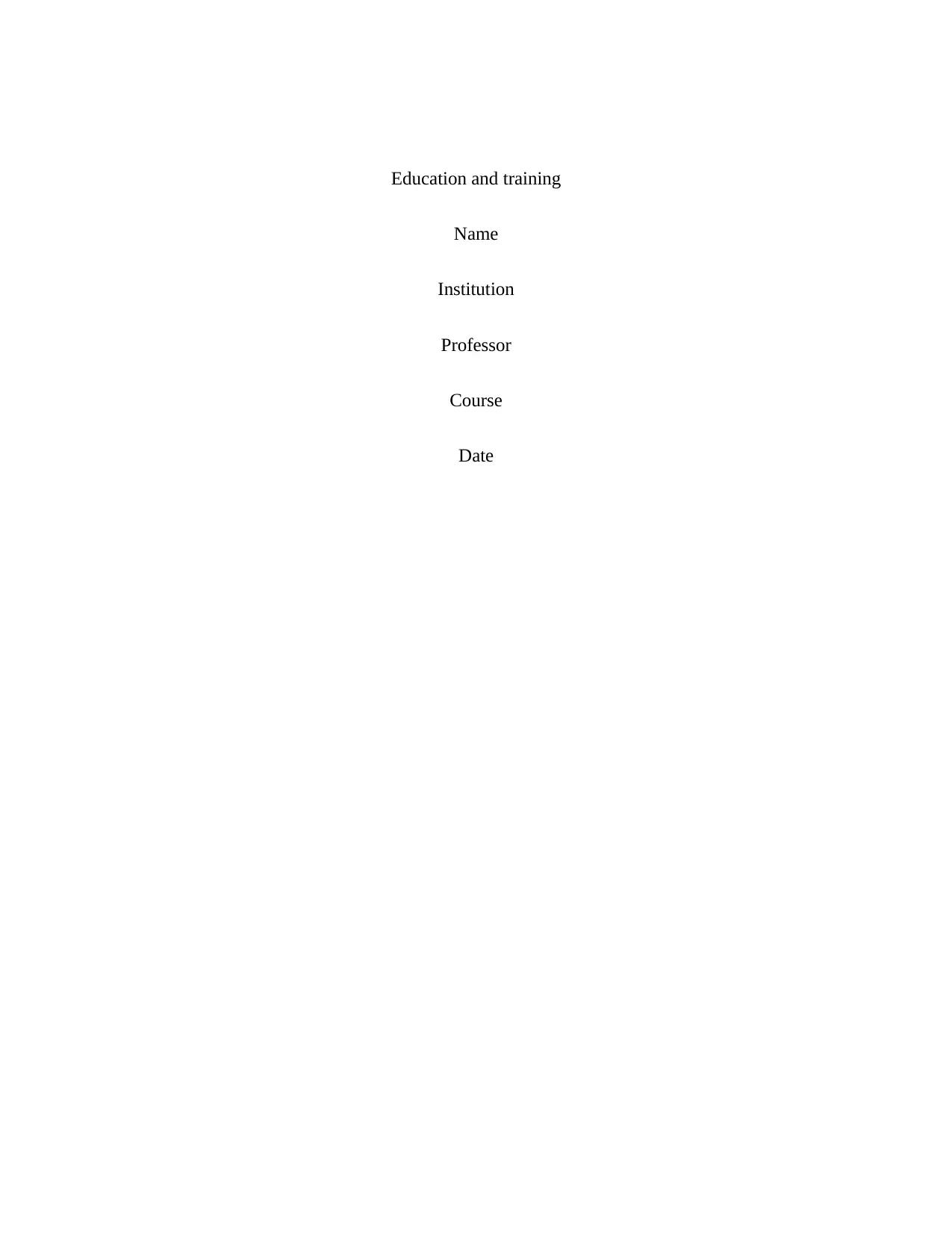
Education and training
Name
Institution
Professor
Course
Date
Name
Institution
Professor
Course
Date
Secure Best Marks with AI Grader
Need help grading? Try our AI Grader for instant feedback on your assignments.
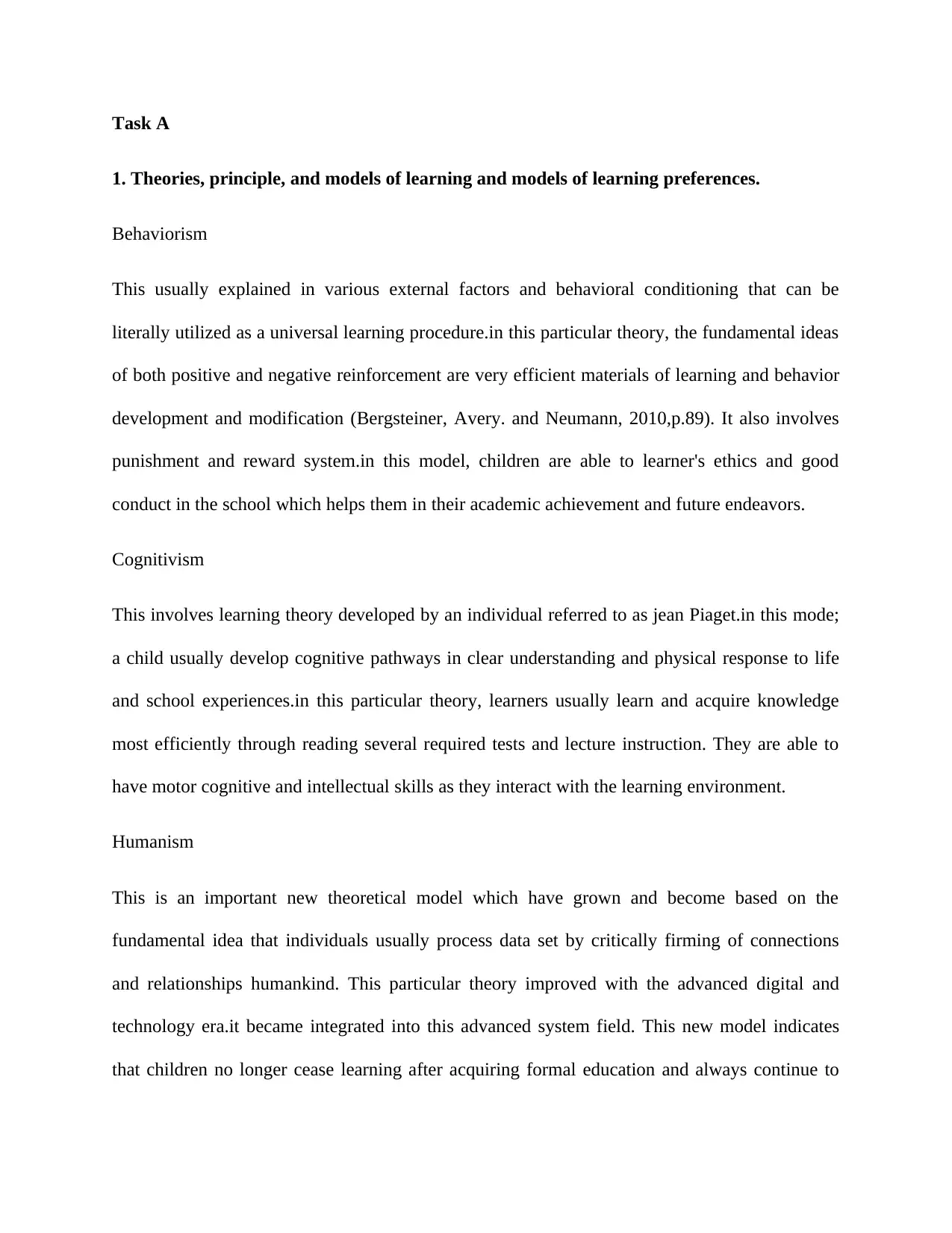
Task A
1. Theories, principle, and models of learning and models of learning preferences.
Behaviorism
This usually explained in various external factors and behavioral conditioning that can be
literally utilized as a universal learning procedure.in this particular theory, the fundamental ideas
of both positive and negative reinforcement are very efficient materials of learning and behavior
development and modification (Bergsteiner, Avery. and Neumann, 2010,p.89). It also involves
punishment and reward system.in this model, children are able to learner's ethics and good
conduct in the school which helps them in their academic achievement and future endeavors.
Cognitivism
This involves learning theory developed by an individual referred to as jean Piaget.in this mode;
a child usually develop cognitive pathways in clear understanding and physical response to life
and school experiences.in this particular theory, learners usually learn and acquire knowledge
most efficiently through reading several required tests and lecture instruction. They are able to
have motor cognitive and intellectual skills as they interact with the learning environment.
Humanism
This is an important new theoretical model which have grown and become based on the
fundamental idea that individuals usually process data set by critically firming of connections
and relationships humankind. This particular theory improved with the advanced digital and
technology era.it became integrated into this advanced system field. This new model indicates
that children no longer cease learning after acquiring formal education and always continue to
1. Theories, principle, and models of learning and models of learning preferences.
Behaviorism
This usually explained in various external factors and behavioral conditioning that can be
literally utilized as a universal learning procedure.in this particular theory, the fundamental ideas
of both positive and negative reinforcement are very efficient materials of learning and behavior
development and modification (Bergsteiner, Avery. and Neumann, 2010,p.89). It also involves
punishment and reward system.in this model, children are able to learner's ethics and good
conduct in the school which helps them in their academic achievement and future endeavors.
Cognitivism
This involves learning theory developed by an individual referred to as jean Piaget.in this mode;
a child usually develop cognitive pathways in clear understanding and physical response to life
and school experiences.in this particular theory, learners usually learn and acquire knowledge
most efficiently through reading several required tests and lecture instruction. They are able to
have motor cognitive and intellectual skills as they interact with the learning environment.
Humanism
This is an important new theoretical model which have grown and become based on the
fundamental idea that individuals usually process data set by critically firming of connections
and relationships humankind. This particular theory improved with the advanced digital and
technology era.it became integrated into this advanced system field. This new model indicates
that children no longer cease learning after acquiring formal education and always continue to
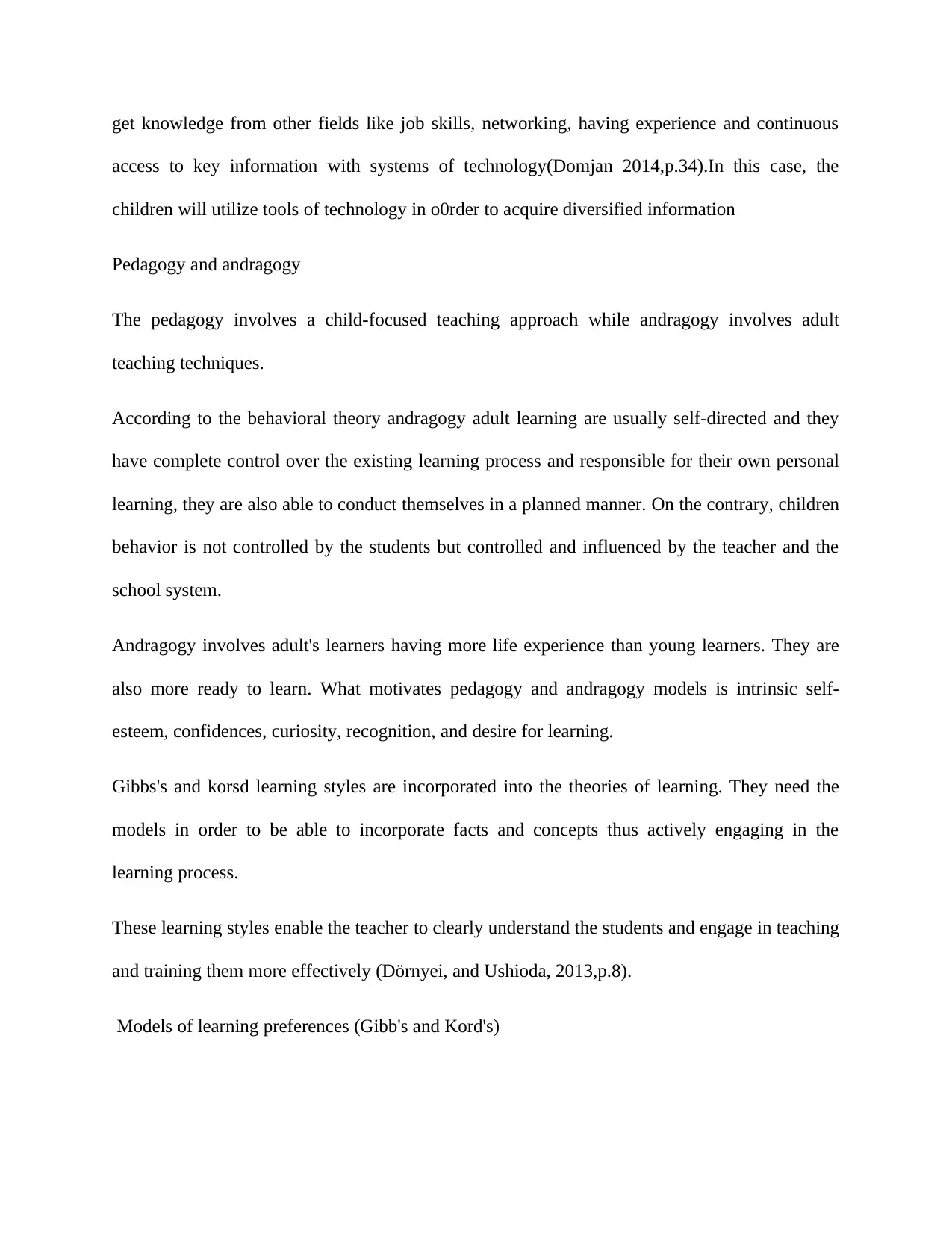
get knowledge from other fields like job skills, networking, having experience and continuous
access to key information with systems of technology(Domjan 2014,p.34).In this case, the
children will utilize tools of technology in o0rder to acquire diversified information
Pedagogy and andragogy
The pedagogy involves a child-focused teaching approach while andragogy involves adult
teaching techniques.
According to the behavioral theory andragogy adult learning are usually self-directed and they
have complete control over the existing learning process and responsible for their own personal
learning, they are also able to conduct themselves in a planned manner. On the contrary, children
behavior is not controlled by the students but controlled and influenced by the teacher and the
school system.
Andragogy involves adult's learners having more life experience than young learners. They are
also more ready to learn. What motivates pedagogy and andragogy models is intrinsic self-
esteem, confidences, curiosity, recognition, and desire for learning.
Gibbs's and korsd learning styles are incorporated into the theories of learning. They need the
models in order to be able to incorporate facts and concepts thus actively engaging in the
learning process.
These learning styles enable the teacher to clearly understand the students and engage in teaching
and training them more effectively (Dörnyei, and Ushioda, 2013,p.8).
Models of learning preferences (Gibb's and Kord's)
access to key information with systems of technology(Domjan 2014,p.34).In this case, the
children will utilize tools of technology in o0rder to acquire diversified information
Pedagogy and andragogy
The pedagogy involves a child-focused teaching approach while andragogy involves adult
teaching techniques.
According to the behavioral theory andragogy adult learning are usually self-directed and they
have complete control over the existing learning process and responsible for their own personal
learning, they are also able to conduct themselves in a planned manner. On the contrary, children
behavior is not controlled by the students but controlled and influenced by the teacher and the
school system.
Andragogy involves adult's learners having more life experience than young learners. They are
also more ready to learn. What motivates pedagogy and andragogy models is intrinsic self-
esteem, confidences, curiosity, recognition, and desire for learning.
Gibbs's and korsd learning styles are incorporated into the theories of learning. They need the
models in order to be able to incorporate facts and concepts thus actively engaging in the
learning process.
These learning styles enable the teacher to clearly understand the students and engage in teaching
and training them more effectively (Dörnyei, and Ushioda, 2013,p.8).
Models of learning preferences (Gibb's and Kord's)
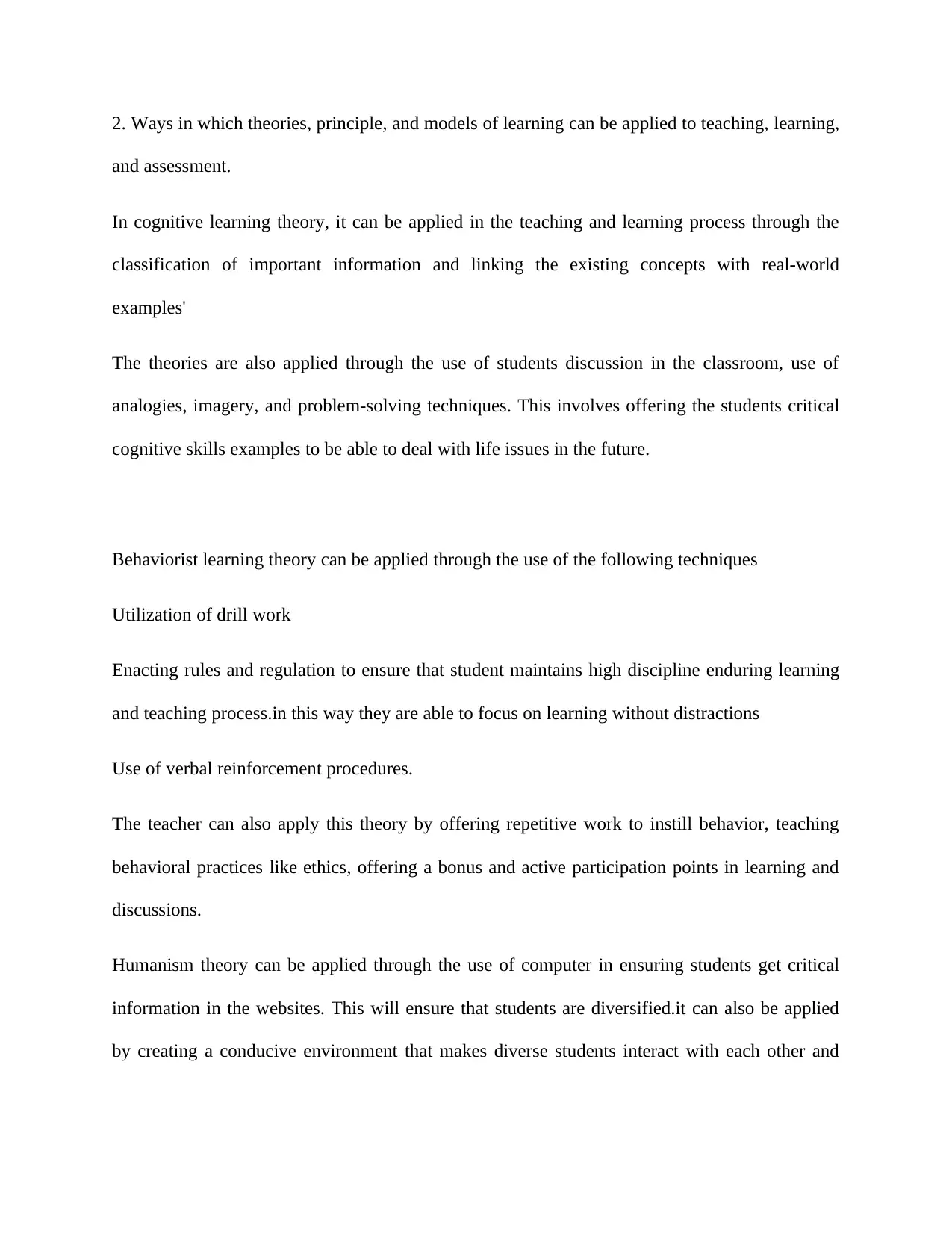
2. Ways in which theories, principle, and models of learning can be applied to teaching, learning,
and assessment.
In cognitive learning theory, it can be applied in the teaching and learning process through the
classification of important information and linking the existing concepts with real-world
examples'
The theories are also applied through the use of students discussion in the classroom, use of
analogies, imagery, and problem-solving techniques. This involves offering the students critical
cognitive skills examples to be able to deal with life issues in the future.
Behaviorist learning theory can be applied through the use of the following techniques
Utilization of drill work
Enacting rules and regulation to ensure that student maintains high discipline enduring learning
and teaching process.in this way they are able to focus on learning without distractions
Use of verbal reinforcement procedures.
The teacher can also apply this theory by offering repetitive work to instill behavior, teaching
behavioral practices like ethics, offering a bonus and active participation points in learning and
discussions.
Humanism theory can be applied through the use of computer in ensuring students get critical
information in the websites. This will ensure that students are diversified.it can also be applied
by creating a conducive environment that makes diverse students interact with each other and
and assessment.
In cognitive learning theory, it can be applied in the teaching and learning process through the
classification of important information and linking the existing concepts with real-world
examples'
The theories are also applied through the use of students discussion in the classroom, use of
analogies, imagery, and problem-solving techniques. This involves offering the students critical
cognitive skills examples to be able to deal with life issues in the future.
Behaviorist learning theory can be applied through the use of the following techniques
Utilization of drill work
Enacting rules and regulation to ensure that student maintains high discipline enduring learning
and teaching process.in this way they are able to focus on learning without distractions
Use of verbal reinforcement procedures.
The teacher can also apply this theory by offering repetitive work to instill behavior, teaching
behavioral practices like ethics, offering a bonus and active participation points in learning and
discussions.
Humanism theory can be applied through the use of computer in ensuring students get critical
information in the websites. This will ensure that students are diversified.it can also be applied
by creating a conducive environment that makes diverse students interact with each other and
Paraphrase This Document
Need a fresh take? Get an instant paraphrase of this document with our AI Paraphraser
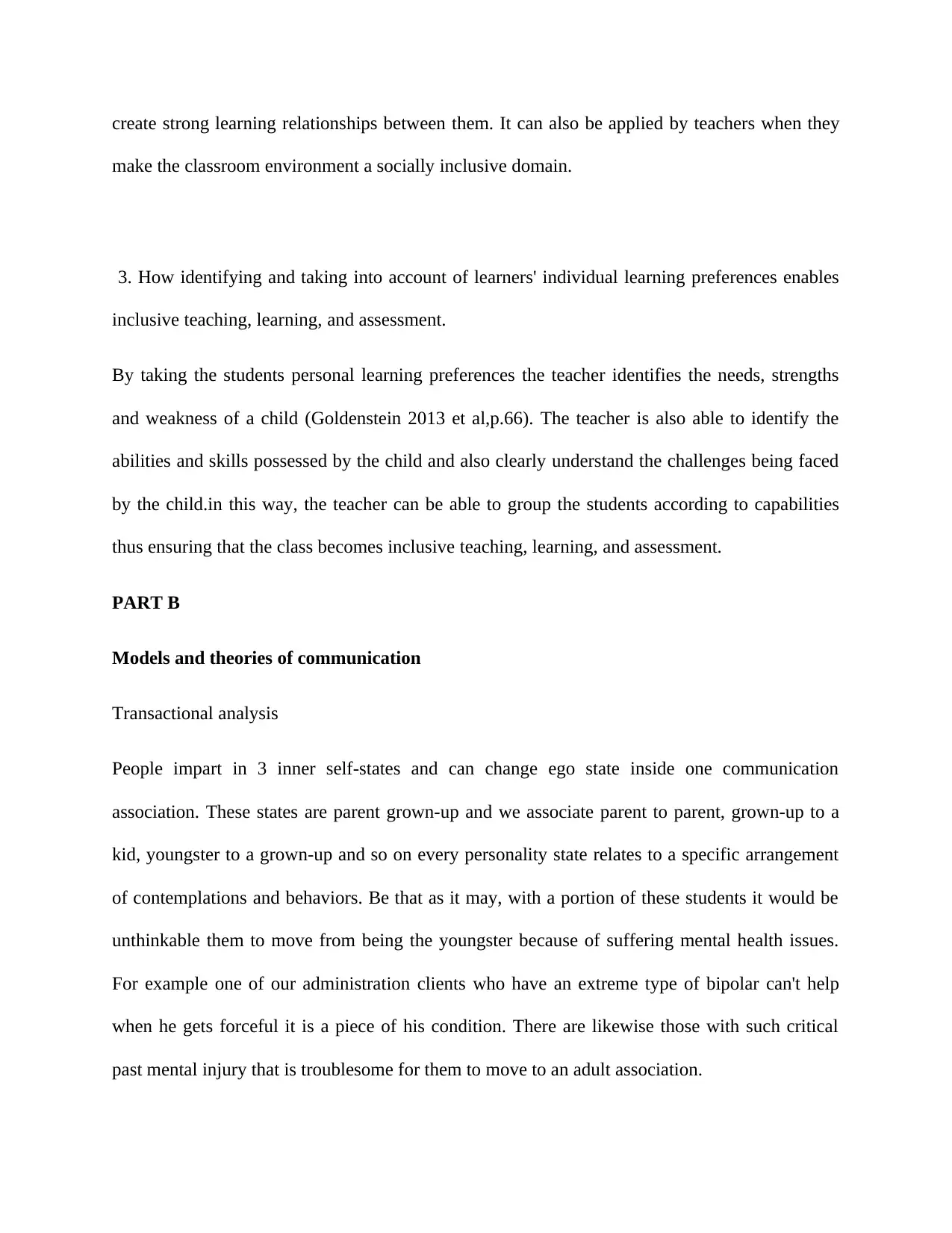
create strong learning relationships between them. It can also be applied by teachers when they
make the classroom environment a socially inclusive domain.
3. How identifying and taking into account of learners' individual learning preferences enables
inclusive teaching, learning, and assessment.
By taking the students personal learning preferences the teacher identifies the needs, strengths
and weakness of a child (Goldenstein 2013 et al,p.66). The teacher is also able to identify the
abilities and skills possessed by the child and also clearly understand the challenges being faced
by the child.in this way, the teacher can be able to group the students according to capabilities
thus ensuring that the class becomes inclusive teaching, learning, and assessment.
PART B
Models and theories of communication
Transactional analysis
People impart in 3 inner self-states and can change ego state inside one communication
association. These states are parent grown-up and we associate parent to parent, grown-up to a
kid, youngster to a grown-up and so on every personality state relates to a specific arrangement
of contemplations and behaviors. Be that as it may, with a portion of these students it would be
unthinkable them to move from being the youngster because of suffering mental health issues.
For example one of our administration clients who have an extreme type of bipolar can't help
when he gets forceful it is a piece of his condition. There are likewise those with such critical
past mental injury that is troublesome for them to move to an adult association.
make the classroom environment a socially inclusive domain.
3. How identifying and taking into account of learners' individual learning preferences enables
inclusive teaching, learning, and assessment.
By taking the students personal learning preferences the teacher identifies the needs, strengths
and weakness of a child (Goldenstein 2013 et al,p.66). The teacher is also able to identify the
abilities and skills possessed by the child and also clearly understand the challenges being faced
by the child.in this way, the teacher can be able to group the students according to capabilities
thus ensuring that the class becomes inclusive teaching, learning, and assessment.
PART B
Models and theories of communication
Transactional analysis
People impart in 3 inner self-states and can change ego state inside one communication
association. These states are parent grown-up and we associate parent to parent, grown-up to a
kid, youngster to a grown-up and so on every personality state relates to a specific arrangement
of contemplations and behaviors. Be that as it may, with a portion of these students it would be
unthinkable them to move from being the youngster because of suffering mental health issues.
For example one of our administration clients who have an extreme type of bipolar can't help
when he gets forceful it is a piece of his condition. There are likewise those with such critical
past mental injury that is troublesome for them to move to an adult association.
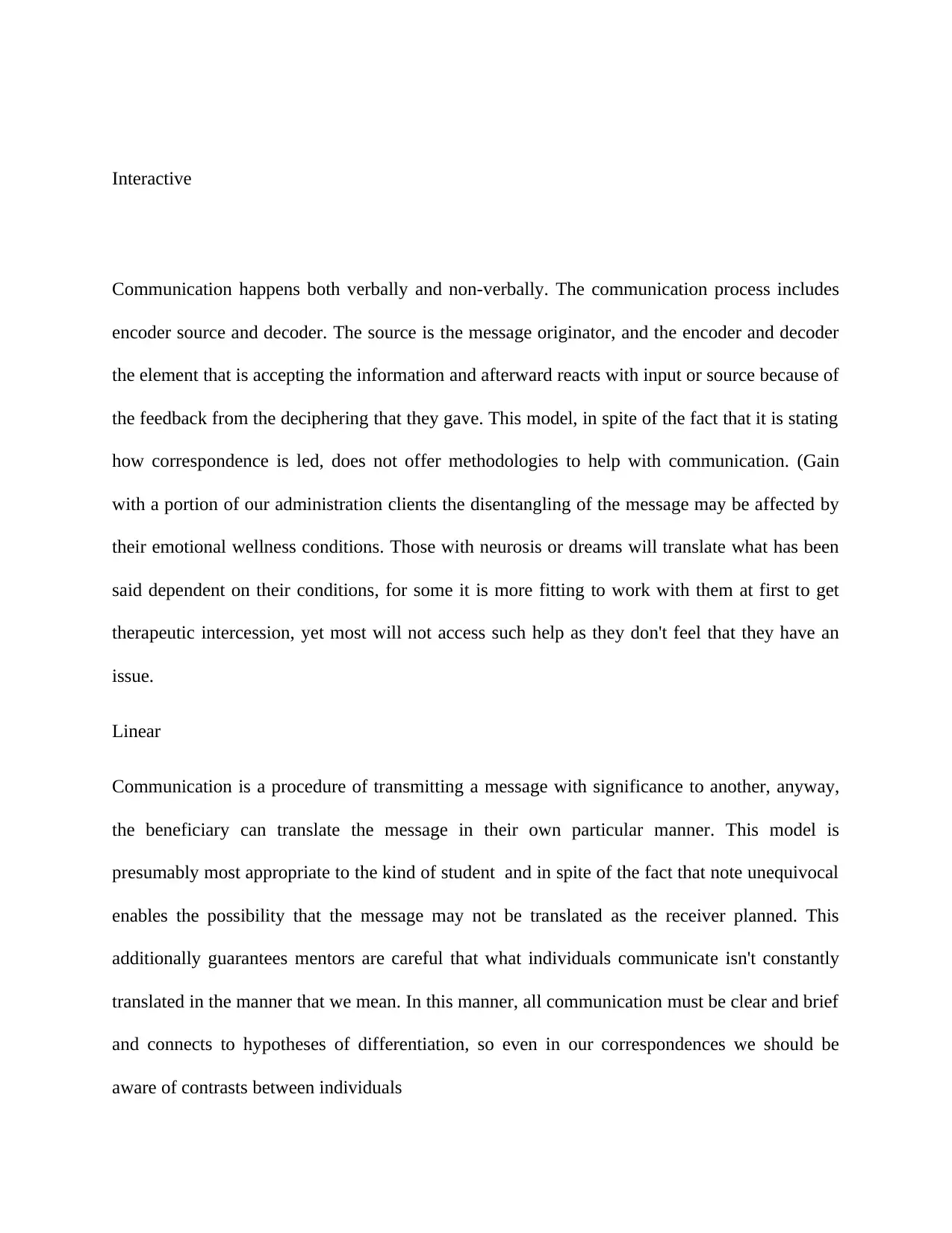
Interactive
Communication happens both verbally and non-verbally. The communication process includes
encoder source and decoder. The source is the message originator, and the encoder and decoder
the element that is accepting the information and afterward reacts with input or source because of
the feedback from the deciphering that they gave. This model, in spite of the fact that it is stating
how correspondence is led, does not offer methodologies to help with communication. (Gain
with a portion of our administration clients the disentangling of the message may be affected by
their emotional wellness conditions. Those with neurosis or dreams will translate what has been
said dependent on their conditions, for some it is more fitting to work with them at first to get
therapeutic intercession, yet most will not access such help as they don't feel that they have an
issue.
Linear
Communication is a procedure of transmitting a message with significance to another, anyway,
the beneficiary can translate the message in their own particular manner. This model is
presumably most appropriate to the kind of student and in spite of the fact that note unequivocal
enables the possibility that the message may not be translated as the receiver planned. This
additionally guarantees mentors are careful that what individuals communicate isn't constantly
translated in the manner that we mean. In this manner, all communication must be clear and brief
and connects to hypotheses of differentiation, so even in our correspondences we should be
aware of contrasts between individuals
Communication happens both verbally and non-verbally. The communication process includes
encoder source and decoder. The source is the message originator, and the encoder and decoder
the element that is accepting the information and afterward reacts with input or source because of
the feedback from the deciphering that they gave. This model, in spite of the fact that it is stating
how correspondence is led, does not offer methodologies to help with communication. (Gain
with a portion of our administration clients the disentangling of the message may be affected by
their emotional wellness conditions. Those with neurosis or dreams will translate what has been
said dependent on their conditions, for some it is more fitting to work with them at first to get
therapeutic intercession, yet most will not access such help as they don't feel that they have an
issue.
Linear
Communication is a procedure of transmitting a message with significance to another, anyway,
the beneficiary can translate the message in their own particular manner. This model is
presumably most appropriate to the kind of student and in spite of the fact that note unequivocal
enables the possibility that the message may not be translated as the receiver planned. This
additionally guarantees mentors are careful that what individuals communicate isn't constantly
translated in the manner that we mean. In this manner, all communication must be clear and brief
and connects to hypotheses of differentiation, so even in our correspondences we should be
aware of contrasts between individuals
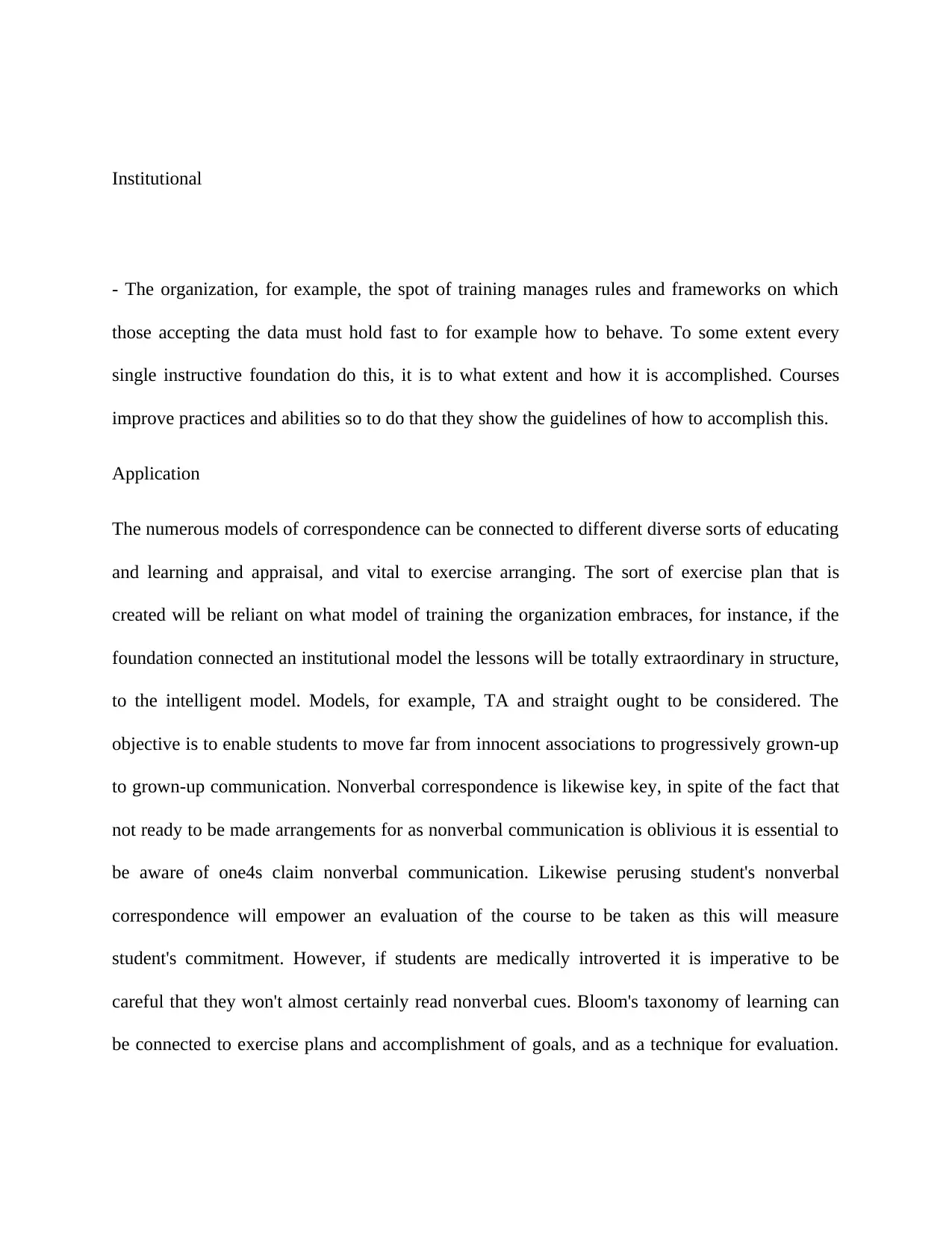
Institutional
- The organization, for example, the spot of training manages rules and frameworks on which
those accepting the data must hold fast to for example how to behave. To some extent every
single instructive foundation do this, it is to what extent and how it is accomplished. Courses
improve practices and abilities so to do that they show the guidelines of how to accomplish this.
Application
The numerous models of correspondence can be connected to different diverse sorts of educating
and learning and appraisal, and vital to exercise arranging. The sort of exercise plan that is
created will be reliant on what model of training the organization embraces, for instance, if the
foundation connected an institutional model the lessons will be totally extraordinary in structure,
to the intelligent model. Models, for example, TA and straight ought to be considered. The
objective is to enable students to move far from innocent associations to progressively grown-up
to grown-up communication. Nonverbal correspondence is likewise key, in spite of the fact that
not ready to be made arrangements for as nonverbal communication is oblivious it is essential to
be aware of one4s claim nonverbal communication. Likewise perusing student's nonverbal
correspondence will empower an evaluation of the course to be taken as this will measure
student's commitment. However, if students are medically introverted it is imperative to be
careful that they won't almost certainly read nonverbal cues. Bloom's taxonomy of learning can
be connected to exercise plans and accomplishment of goals, and as a technique for evaluation.
- The organization, for example, the spot of training manages rules and frameworks on which
those accepting the data must hold fast to for example how to behave. To some extent every
single instructive foundation do this, it is to what extent and how it is accomplished. Courses
improve practices and abilities so to do that they show the guidelines of how to accomplish this.
Application
The numerous models of correspondence can be connected to different diverse sorts of educating
and learning and appraisal, and vital to exercise arranging. The sort of exercise plan that is
created will be reliant on what model of training the organization embraces, for instance, if the
foundation connected an institutional model the lessons will be totally extraordinary in structure,
to the intelligent model. Models, for example, TA and straight ought to be considered. The
objective is to enable students to move far from innocent associations to progressively grown-up
to grown-up communication. Nonverbal correspondence is likewise key, in spite of the fact that
not ready to be made arrangements for as nonverbal communication is oblivious it is essential to
be aware of one4s claim nonverbal communication. Likewise perusing student's nonverbal
correspondence will empower an evaluation of the course to be taken as this will measure
student's commitment. However, if students are medically introverted it is imperative to be
careful that they won't almost certainly read nonverbal cues. Bloom's taxonomy of learning can
be connected to exercise plans and accomplishment of goals, and as a technique for evaluation.
Secure Best Marks with AI Grader
Need help grading? Try our AI Grader for instant feedback on your assignments.
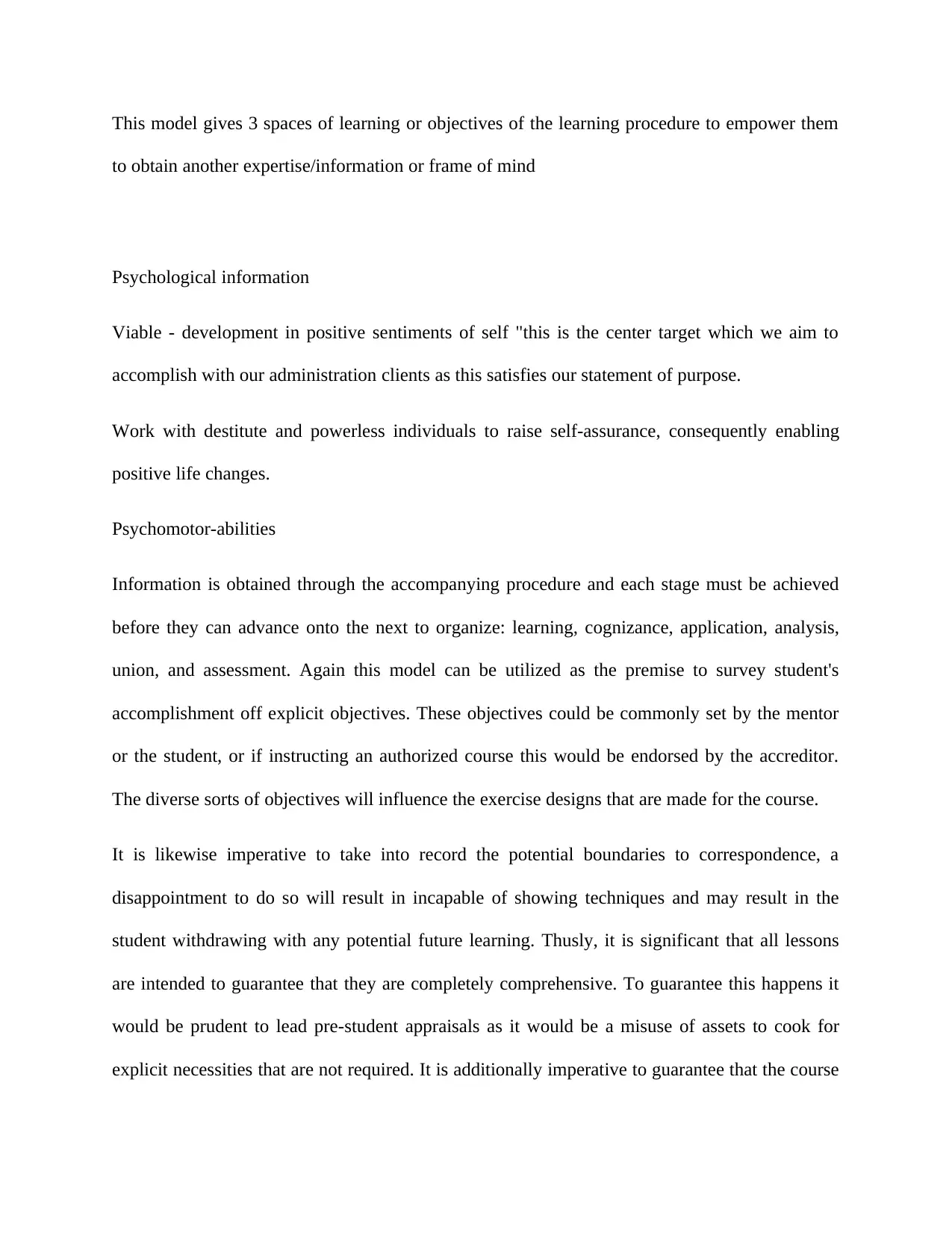
This model gives 3 spaces of learning or objectives of the learning procedure to empower them
to obtain another expertise/information or frame of mind
Psychological information
Viable - development in positive sentiments of self "this is the center target which we aim to
accomplish with our administration clients as this satisfies our statement of purpose.
Work with destitute and powerless individuals to raise self-assurance, consequently enabling
positive life changes.
Psychomotor-abilities
Information is obtained through the accompanying procedure and each stage must be achieved
before they can advance onto the next to organize: learning, cognizance, application, analysis,
union, and assessment. Again this model can be utilized as the premise to survey student's
accomplishment off explicit objectives. These objectives could be commonly set by the mentor
or the student, or if instructing an authorized course this would be endorsed by the accreditor.
The diverse sorts of objectives will influence the exercise designs that are made for the course.
It is likewise imperative to take into record the potential boundaries to correspondence, a
disappointment to do so will result in incapable of showing techniques and may result in the
student withdrawing with any potential future learning. Thusly, it is significant that all lessons
are intended to guarantee that they are completely comprehensive. To guarantee this happens it
would be prudent to lead pre-student appraisals as it would be a misuse of assets to cook for
explicit necessities that are not required. It is additionally imperative to guarantee that the course
to obtain another expertise/information or frame of mind
Psychological information
Viable - development in positive sentiments of self "this is the center target which we aim to
accomplish with our administration clients as this satisfies our statement of purpose.
Work with destitute and powerless individuals to raise self-assurance, consequently enabling
positive life changes.
Psychomotor-abilities
Information is obtained through the accompanying procedure and each stage must be achieved
before they can advance onto the next to organize: learning, cognizance, application, analysis,
union, and assessment. Again this model can be utilized as the premise to survey student's
accomplishment off explicit objectives. These objectives could be commonly set by the mentor
or the student, or if instructing an authorized course this would be endorsed by the accreditor.
The diverse sorts of objectives will influence the exercise designs that are made for the course.
It is likewise imperative to take into record the potential boundaries to correspondence, a
disappointment to do so will result in incapable of showing techniques and may result in the
student withdrawing with any potential future learning. Thusly, it is significant that all lessons
are intended to guarantee that they are completely comprehensive. To guarantee this happens it
would be prudent to lead pre-student appraisals as it would be a misuse of assets to cook for
explicit necessities that are not required. It is additionally imperative to guarantee that the course
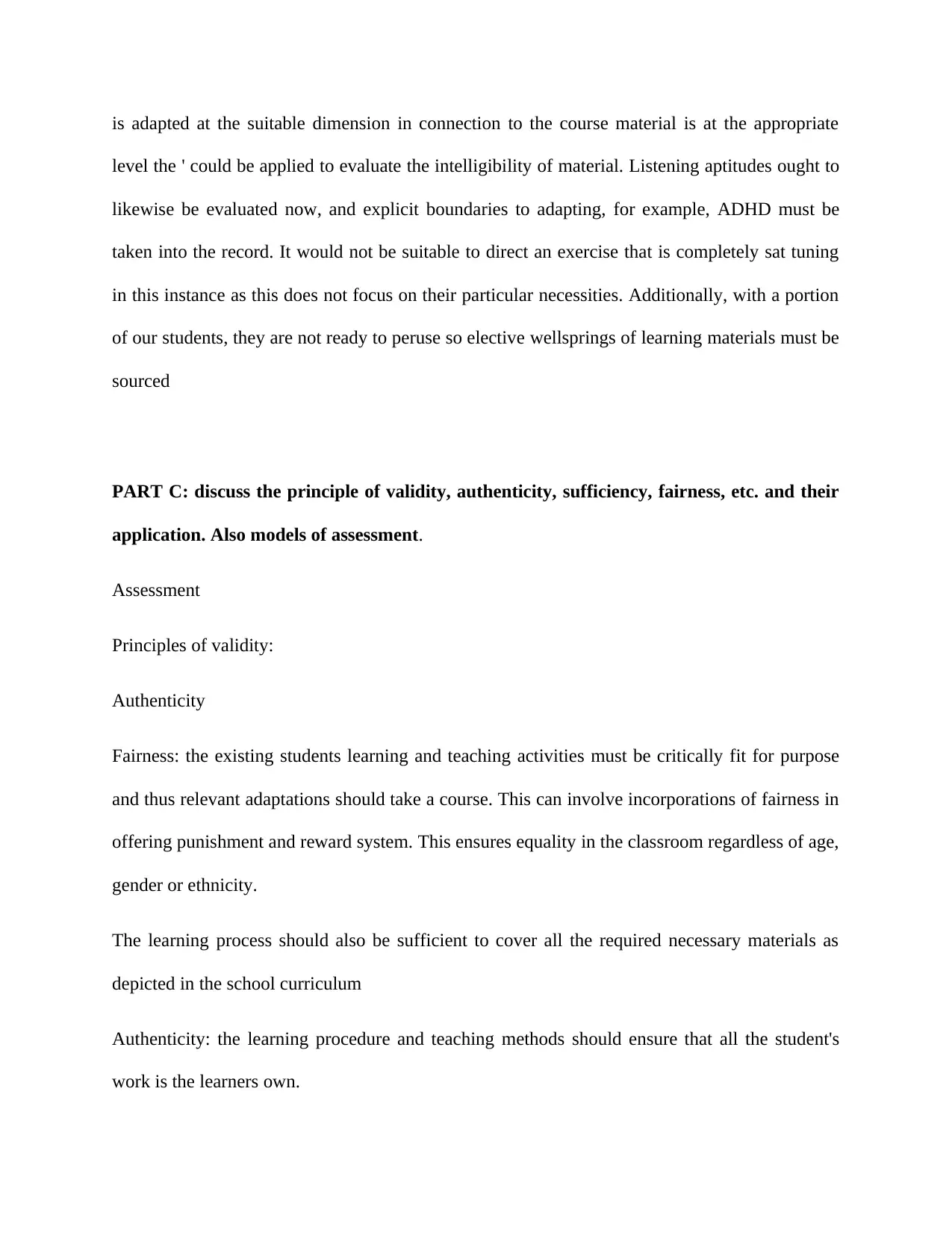
is adapted at the suitable dimension in connection to the course material is at the appropriate
level the ' could be applied to evaluate the intelligibility of material. Listening aptitudes ought to
likewise be evaluated now, and explicit boundaries to adapting, for example, ADHD must be
taken into the record. It would not be suitable to direct an exercise that is completely sat tuning
in this instance as this does not focus on their particular necessities. Additionally, with a portion
of our students, they are not ready to peruse so elective wellsprings of learning materials must be
sourced
PART C: discuss the principle of validity, authenticity, sufficiency, fairness, etc. and their
application. Also models of assessment.
Assessment
Principles of validity:
Authenticity
Fairness: the existing students learning and teaching activities must be critically fit for purpose
and thus relevant adaptations should take a course. This can involve incorporations of fairness in
offering punishment and reward system. This ensures equality in the classroom regardless of age,
gender or ethnicity.
The learning process should also be sufficient to cover all the required necessary materials as
depicted in the school curriculum
Authenticity: the learning procedure and teaching methods should ensure that all the student's
work is the learners own.
level the ' could be applied to evaluate the intelligibility of material. Listening aptitudes ought to
likewise be evaluated now, and explicit boundaries to adapting, for example, ADHD must be
taken into the record. It would not be suitable to direct an exercise that is completely sat tuning
in this instance as this does not focus on their particular necessities. Additionally, with a portion
of our students, they are not ready to peruse so elective wellsprings of learning materials must be
sourced
PART C: discuss the principle of validity, authenticity, sufficiency, fairness, etc. and their
application. Also models of assessment.
Assessment
Principles of validity:
Authenticity
Fairness: the existing students learning and teaching activities must be critically fit for purpose
and thus relevant adaptations should take a course. This can involve incorporations of fairness in
offering punishment and reward system. This ensures equality in the classroom regardless of age,
gender or ethnicity.
The learning process should also be sufficient to cover all the required necessary materials as
depicted in the school curriculum
Authenticity: the learning procedure and teaching methods should ensure that all the student's
work is the learners own.
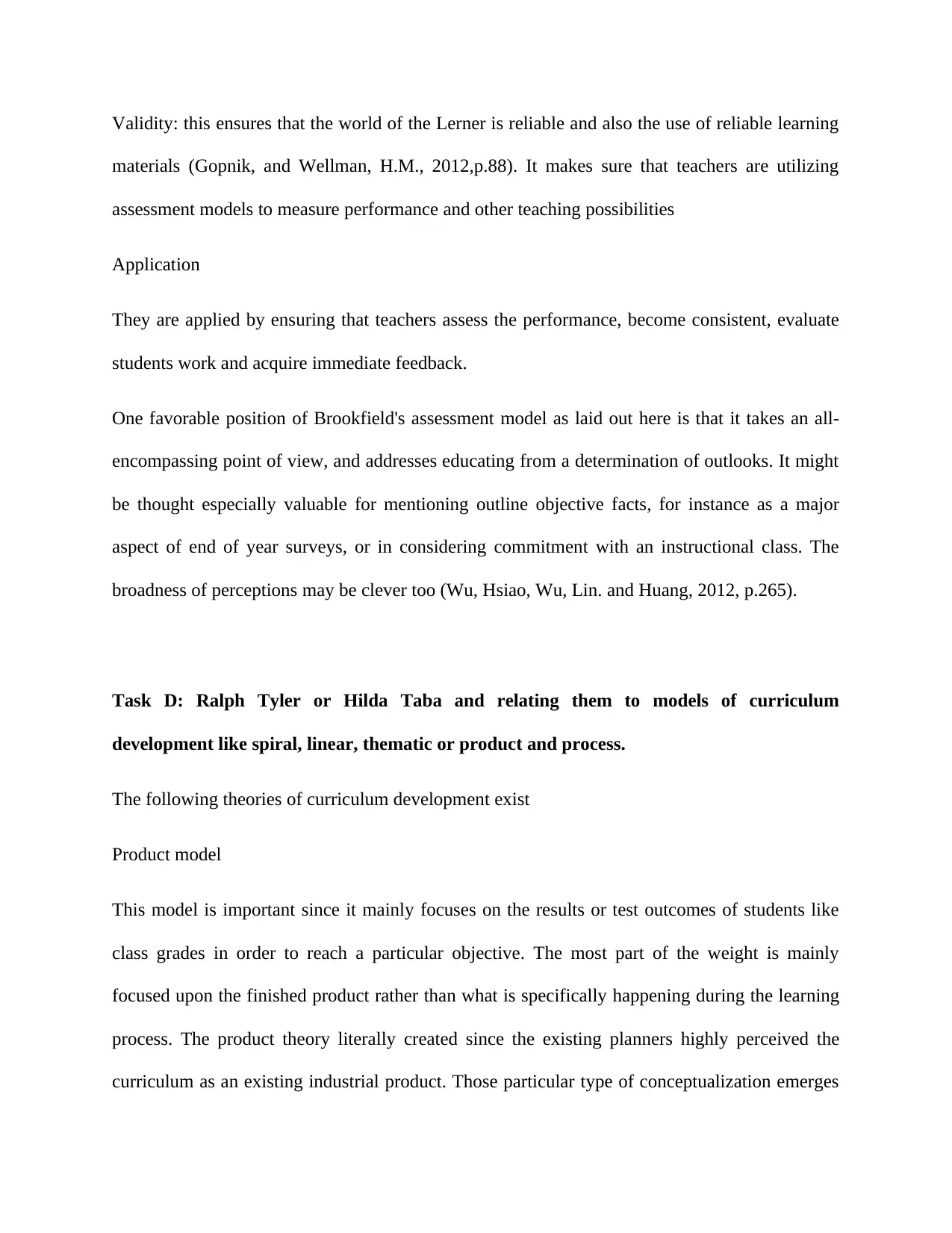
Validity: this ensures that the world of the Lerner is reliable and also the use of reliable learning
materials (Gopnik, and Wellman, H.M., 2012,p.88). It makes sure that teachers are utilizing
assessment models to measure performance and other teaching possibilities
Application
They are applied by ensuring that teachers assess the performance, become consistent, evaluate
students work and acquire immediate feedback.
One favorable position of Brookfield's assessment model as laid out here is that it takes an all-
encompassing point of view, and addresses educating from a determination of outlooks. It might
be thought especially valuable for mentioning outline objective facts, for instance as a major
aspect of end of year surveys, or in considering commitment with an instructional class. The
broadness of perceptions may be clever too (Wu, Hsiao, Wu, Lin. and Huang, 2012, p.265).
Task D: Ralph Tyler or Hilda Taba and relating them to models of curriculum
development like spiral, linear, thematic or product and process.
The following theories of curriculum development exist
Product model
This model is important since it mainly focuses on the results or test outcomes of students like
class grades in order to reach a particular objective. The most part of the weight is mainly
focused upon the finished product rather than what is specifically happening during the learning
process. The product theory literally created since the existing planners highly perceived the
curriculum as an existing industrial product. Those particular type of conceptualization emerges
materials (Gopnik, and Wellman, H.M., 2012,p.88). It makes sure that teachers are utilizing
assessment models to measure performance and other teaching possibilities
Application
They are applied by ensuring that teachers assess the performance, become consistent, evaluate
students work and acquire immediate feedback.
One favorable position of Brookfield's assessment model as laid out here is that it takes an all-
encompassing point of view, and addresses educating from a determination of outlooks. It might
be thought especially valuable for mentioning outline objective facts, for instance as a major
aspect of end of year surveys, or in considering commitment with an instructional class. The
broadness of perceptions may be clever too (Wu, Hsiao, Wu, Lin. and Huang, 2012, p.265).
Task D: Ralph Tyler or Hilda Taba and relating them to models of curriculum
development like spiral, linear, thematic or product and process.
The following theories of curriculum development exist
Product model
This model is important since it mainly focuses on the results or test outcomes of students like
class grades in order to reach a particular objective. The most part of the weight is mainly
focused upon the finished product rather than what is specifically happening during the learning
process. The product theory literally created since the existing planners highly perceived the
curriculum as an existing industrial product. Those particular type of conceptualization emerges
Paraphrase This Document
Need a fresh take? Get an instant paraphrase of this document with our AI Paraphraser

from the social environment in the case where both industrialist and bureaucratic are the most
common ones. Product curriculum ensures that the learning is technologically advanced. The
product model is traced back to the important work of the writing of Ralph Tyler who highly
influenced the American curriculum development models. According to Tyler the product model
transforms and develops valuable transparent results in children achievement.
Thematic analysis as a scientific approach as a curriculum development model involves a key
blueprint of structuring the environment for critical learning.it is logical and quite effective in
ensuring education strategies are delivered. On technical model in comparison is mainly focused
and subjective of the learner borrowing some of its main ideas from the process model.
Theories, principle, and models of learning and models of learning preferences
The process model
This theory usually focuses on how things happened in the learning and is quite more open-
ended.it mainly emphasizes on the active procedures of learning and teaching. The above talk
demonstrates that distinctive methodologies of educational modules improvement are the
aftereffects of various power designs. Ralph Tyler explains that the innovator educational
modules are structured in light of the fact that organizers saw educational modules as a
mechanical item, which pursues unmistakable assembling strategies. This sort of
conceptualization emerges from the social condition, where industrialization and
bureaucratization are the most overwhelming wonder (Knowles, Holton III, and Swanson,
2012,p.89). The usefulness demonstrated by modernization at a specific period turns into an
incredible system, the power of which is spread to other social foundations. Thus, it is reasonable
to portray that the advanced educational programs are an impression of the power structure of the
common ones. Product curriculum ensures that the learning is technologically advanced. The
product model is traced back to the important work of the writing of Ralph Tyler who highly
influenced the American curriculum development models. According to Tyler the product model
transforms and develops valuable transparent results in children achievement.
Thematic analysis as a scientific approach as a curriculum development model involves a key
blueprint of structuring the environment for critical learning.it is logical and quite effective in
ensuring education strategies are delivered. On technical model in comparison is mainly focused
and subjective of the learner borrowing some of its main ideas from the process model.
Theories, principle, and models of learning and models of learning preferences
The process model
This theory usually focuses on how things happened in the learning and is quite more open-
ended.it mainly emphasizes on the active procedures of learning and teaching. The above talk
demonstrates that distinctive methodologies of educational modules improvement are the
aftereffects of various power designs. Ralph Tyler explains that the innovator educational
modules are structured in light of the fact that organizers saw educational modules as a
mechanical item, which pursues unmistakable assembling strategies. This sort of
conceptualization emerges from the social condition, where industrialization and
bureaucratization are the most overwhelming wonder (Knowles, Holton III, and Swanson,
2012,p.89). The usefulness demonstrated by modernization at a specific period turns into an
incredible system, the power of which is spread to other social foundations. Thus, it is reasonable
to portray that the advanced educational programs are an impression of the power structure of the
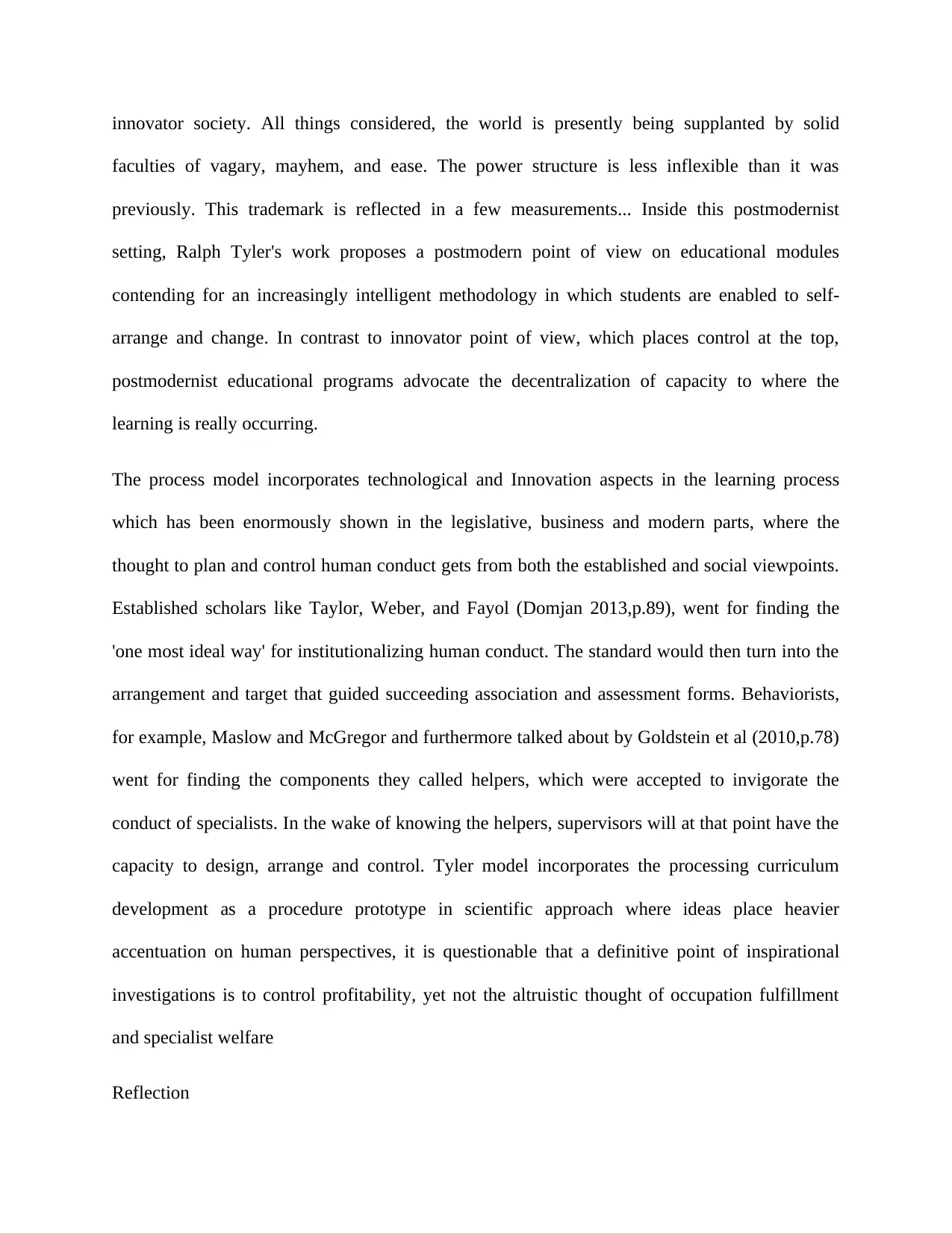
innovator society. All things considered, the world is presently being supplanted by solid
faculties of vagary, mayhem, and ease. The power structure is less inflexible than it was
previously. This trademark is reflected in a few measurements... Inside this postmodernist
setting, Ralph Tyler's work proposes a postmodern point of view on educational modules
contending for an increasingly intelligent methodology in which students are enabled to self-
arrange and change. In contrast to innovator point of view, which places control at the top,
postmodernist educational programs advocate the decentralization of capacity to where the
learning is really occurring.
The process model incorporates technological and Innovation aspects in the learning process
which has been enormously shown in the legislative, business and modern parts, where the
thought to plan and control human conduct gets from both the established and social viewpoints.
Established scholars like Taylor, Weber, and Fayol (Domjan 2013,p.89), went for finding the
'one most ideal way' for institutionalizing human conduct. The standard would then turn into the
arrangement and target that guided succeeding association and assessment forms. Behaviorists,
for example, Maslow and McGregor and furthermore talked about by Goldstein et al (2010,p.78)
went for finding the components they called helpers, which were accepted to invigorate the
conduct of specialists. In the wake of knowing the helpers, supervisors will at that point have the
capacity to design, arrange and control. Tyler model incorporates the processing curriculum
development as a procedure prototype in scientific approach where ideas place heavier
accentuation on human perspectives, it is questionable that a definitive point of inspirational
investigations is to control profitability, yet not the altruistic thought of occupation fulfillment
and specialist welfare
Reflection
faculties of vagary, mayhem, and ease. The power structure is less inflexible than it was
previously. This trademark is reflected in a few measurements... Inside this postmodernist
setting, Ralph Tyler's work proposes a postmodern point of view on educational modules
contending for an increasingly intelligent methodology in which students are enabled to self-
arrange and change. In contrast to innovator point of view, which places control at the top,
postmodernist educational programs advocate the decentralization of capacity to where the
learning is really occurring.
The process model incorporates technological and Innovation aspects in the learning process
which has been enormously shown in the legislative, business and modern parts, where the
thought to plan and control human conduct gets from both the established and social viewpoints.
Established scholars like Taylor, Weber, and Fayol (Domjan 2013,p.89), went for finding the
'one most ideal way' for institutionalizing human conduct. The standard would then turn into the
arrangement and target that guided succeeding association and assessment forms. Behaviorists,
for example, Maslow and McGregor and furthermore talked about by Goldstein et al (2010,p.78)
went for finding the components they called helpers, which were accepted to invigorate the
conduct of specialists. In the wake of knowing the helpers, supervisors will at that point have the
capacity to design, arrange and control. Tyler model incorporates the processing curriculum
development as a procedure prototype in scientific approach where ideas place heavier
accentuation on human perspectives, it is questionable that a definitive point of inspirational
investigations is to control profitability, yet not the altruistic thought of occupation fulfillment
and specialist welfare
Reflection
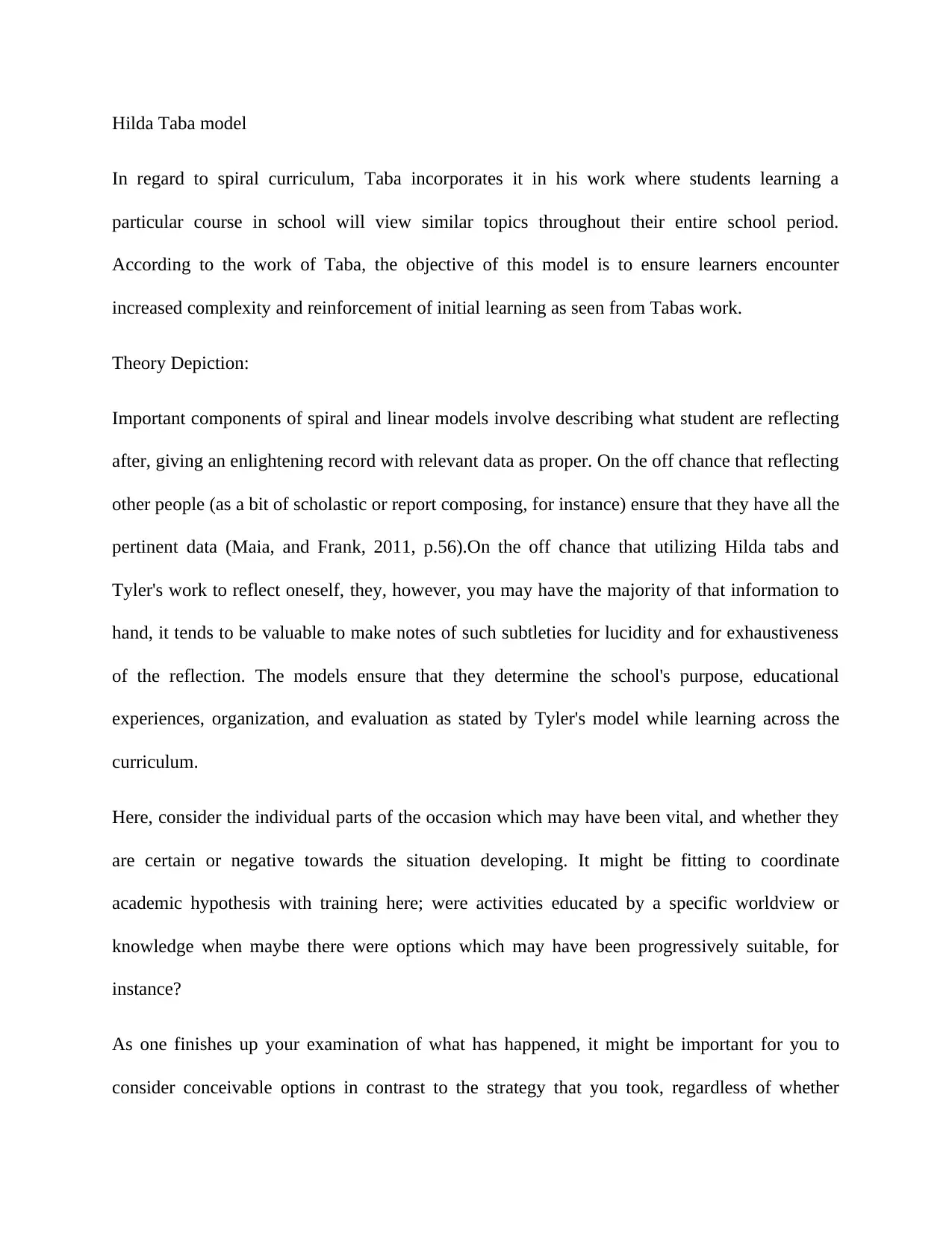
Hilda Taba model
In regard to spiral curriculum, Taba incorporates it in his work where students learning a
particular course in school will view similar topics throughout their entire school period.
According to the work of Taba, the objective of this model is to ensure learners encounter
increased complexity and reinforcement of initial learning as seen from Tabas work.
Theory Depiction:
Important components of spiral and linear models involve describing what student are reflecting
after, giving an enlightening record with relevant data as proper. On the off chance that reflecting
other people (as a bit of scholastic or report composing, for instance) ensure that they have all the
pertinent data (Maia, and Frank, 2011, p.56).On the off chance that utilizing Hilda tabs and
Tyler's work to reflect oneself, they, however, you may have the majority of that information to
hand, it tends to be valuable to make notes of such subtleties for lucidity and for exhaustiveness
of the reflection. The models ensure that they determine the school's purpose, educational
experiences, organization, and evaluation as stated by Tyler's model while learning across the
curriculum.
Here, consider the individual parts of the occasion which may have been vital, and whether they
are certain or negative towards the situation developing. It might be fitting to coordinate
academic hypothesis with training here; were activities educated by a specific worldview or
knowledge when maybe there were options which may have been progressively suitable, for
instance?
As one finishes up your examination of what has happened, it might be important for you to
consider conceivable options in contrast to the strategy that you took, regardless of whether
In regard to spiral curriculum, Taba incorporates it in his work where students learning a
particular course in school will view similar topics throughout their entire school period.
According to the work of Taba, the objective of this model is to ensure learners encounter
increased complexity and reinforcement of initial learning as seen from Tabas work.
Theory Depiction:
Important components of spiral and linear models involve describing what student are reflecting
after, giving an enlightening record with relevant data as proper. On the off chance that reflecting
other people (as a bit of scholastic or report composing, for instance) ensure that they have all the
pertinent data (Maia, and Frank, 2011, p.56).On the off chance that utilizing Hilda tabs and
Tyler's work to reflect oneself, they, however, you may have the majority of that information to
hand, it tends to be valuable to make notes of such subtleties for lucidity and for exhaustiveness
of the reflection. The models ensure that they determine the school's purpose, educational
experiences, organization, and evaluation as stated by Tyler's model while learning across the
curriculum.
Here, consider the individual parts of the occasion which may have been vital, and whether they
are certain or negative towards the situation developing. It might be fitting to coordinate
academic hypothesis with training here; were activities educated by a specific worldview or
knowledge when maybe there were options which may have been progressively suitable, for
instance?
As one finishes up your examination of what has happened, it might be important for you to
consider conceivable options in contrast to the strategy that you took, regardless of whether
Secure Best Marks with AI Grader
Need help grading? Try our AI Grader for instant feedback on your assignments.
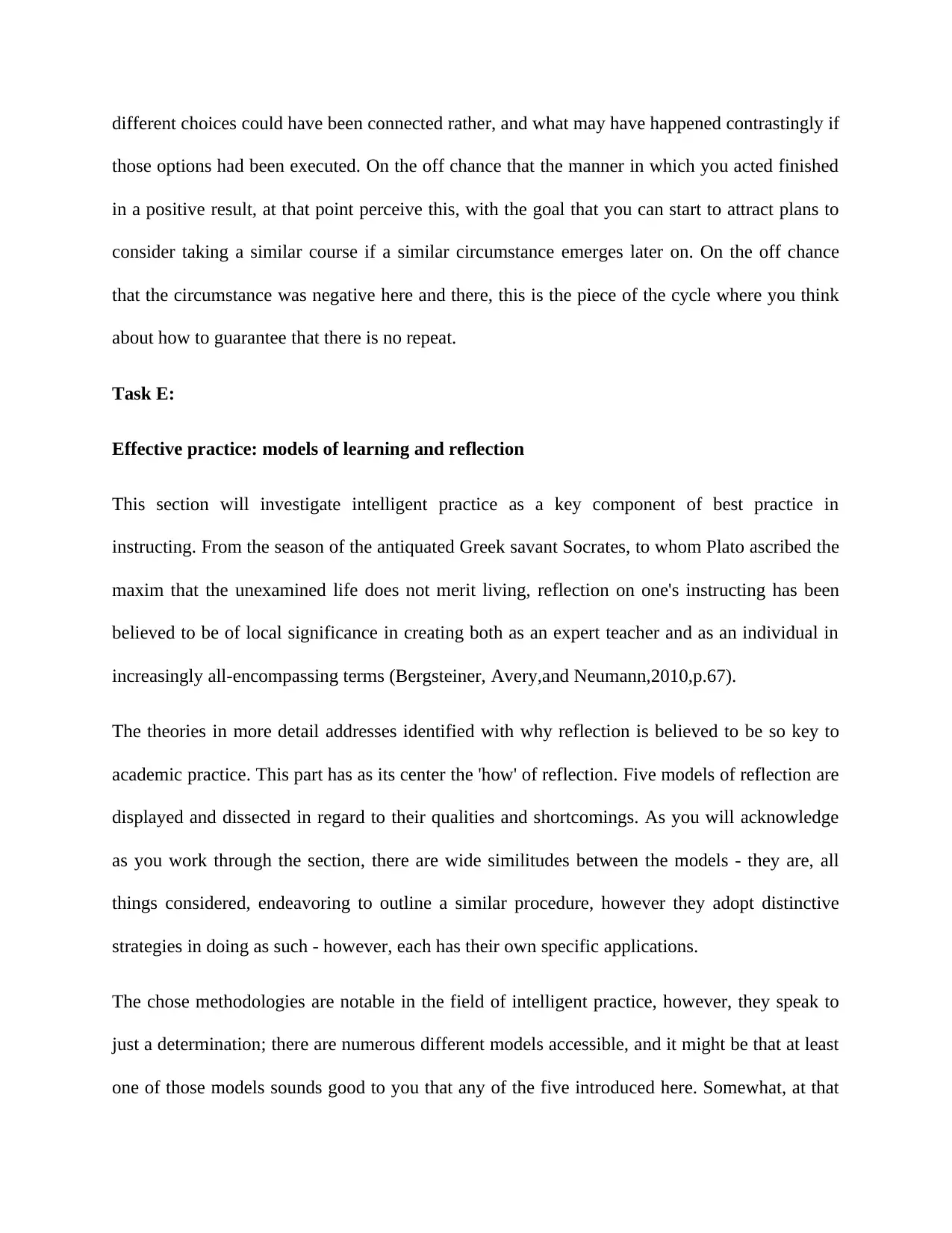
different choices could have been connected rather, and what may have happened contrastingly if
those options had been executed. On the off chance that the manner in which you acted finished
in a positive result, at that point perceive this, with the goal that you can start to attract plans to
consider taking a similar course if a similar circumstance emerges later on. On the off chance
that the circumstance was negative here and there, this is the piece of the cycle where you think
about how to guarantee that there is no repeat.
Task E:
Effective practice: models of learning and reflection
This section will investigate intelligent practice as a key component of best practice in
instructing. From the season of the antiquated Greek savant Socrates, to whom Plato ascribed the
maxim that the unexamined life does not merit living, reflection on one's instructing has been
believed to be of local significance in creating both as an expert teacher and as an individual in
increasingly all-encompassing terms (Bergsteiner, Avery,and Neumann,2010,p.67).
The theories in more detail addresses identified with why reflection is believed to be so key to
academic practice. This part has as its center the 'how' of reflection. Five models of reflection are
displayed and dissected in regard to their qualities and shortcomings. As you will acknowledge
as you work through the section, there are wide similitudes between the models - they are, all
things considered, endeavoring to outline a similar procedure, however they adopt distinctive
strategies in doing as such - however, each has their own specific applications.
The chose methodologies are notable in the field of intelligent practice, however, they speak to
just a determination; there are numerous different models accessible, and it might be that at least
one of those models sounds good to you that any of the five introduced here. Somewhat, at that
those options had been executed. On the off chance that the manner in which you acted finished
in a positive result, at that point perceive this, with the goal that you can start to attract plans to
consider taking a similar course if a similar circumstance emerges later on. On the off chance
that the circumstance was negative here and there, this is the piece of the cycle where you think
about how to guarantee that there is no repeat.
Task E:
Effective practice: models of learning and reflection
This section will investigate intelligent practice as a key component of best practice in
instructing. From the season of the antiquated Greek savant Socrates, to whom Plato ascribed the
maxim that the unexamined life does not merit living, reflection on one's instructing has been
believed to be of local significance in creating both as an expert teacher and as an individual in
increasingly all-encompassing terms (Bergsteiner, Avery,and Neumann,2010,p.67).
The theories in more detail addresses identified with why reflection is believed to be so key to
academic practice. This part has as its center the 'how' of reflection. Five models of reflection are
displayed and dissected in regard to their qualities and shortcomings. As you will acknowledge
as you work through the section, there are wide similitudes between the models - they are, all
things considered, endeavoring to outline a similar procedure, however they adopt distinctive
strategies in doing as such - however, each has their own specific applications.
The chose methodologies are notable in the field of intelligent practice, however, they speak to
just a determination; there are numerous different models accessible, and it might be that at least
one of those models sounds good to you that any of the five introduced here. Somewhat, at that
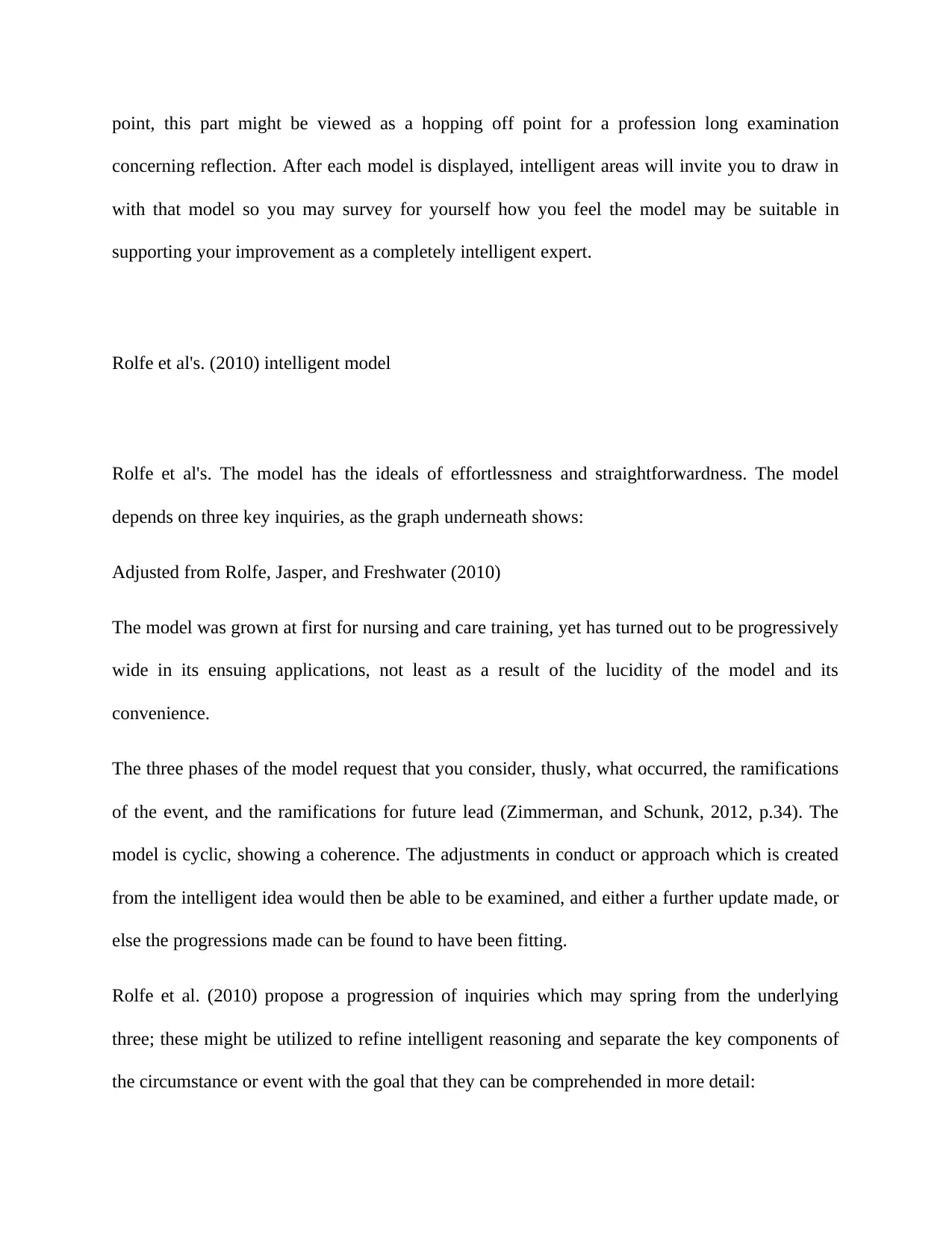
point, this part might be viewed as a hopping off point for a profession long examination
concerning reflection. After each model is displayed, intelligent areas will invite you to draw in
with that model so you may survey for yourself how you feel the model may be suitable in
supporting your improvement as a completely intelligent expert.
Rolfe et al's. (2010) intelligent model
Rolfe et al's. The model has the ideals of effortlessness and straightforwardness. The model
depends on three key inquiries, as the graph underneath shows:
Adjusted from Rolfe, Jasper, and Freshwater (2010)
The model was grown at first for nursing and care training, yet has turned out to be progressively
wide in its ensuing applications, not least as a result of the lucidity of the model and its
convenience.
The three phases of the model request that you consider, thusly, what occurred, the ramifications
of the event, and the ramifications for future lead (Zimmerman, and Schunk, 2012, p.34). The
model is cyclic, showing a coherence. The adjustments in conduct or approach which is created
from the intelligent idea would then be able to be examined, and either a further update made, or
else the progressions made can be found to have been fitting.
Rolfe et al. (2010) propose a progression of inquiries which may spring from the underlying
three; these might be utilized to refine intelligent reasoning and separate the key components of
the circumstance or event with the goal that they can be comprehended in more detail:
concerning reflection. After each model is displayed, intelligent areas will invite you to draw in
with that model so you may survey for yourself how you feel the model may be suitable in
supporting your improvement as a completely intelligent expert.
Rolfe et al's. (2010) intelligent model
Rolfe et al's. The model has the ideals of effortlessness and straightforwardness. The model
depends on three key inquiries, as the graph underneath shows:
Adjusted from Rolfe, Jasper, and Freshwater (2010)
The model was grown at first for nursing and care training, yet has turned out to be progressively
wide in its ensuing applications, not least as a result of the lucidity of the model and its
convenience.
The three phases of the model request that you consider, thusly, what occurred, the ramifications
of the event, and the ramifications for future lead (Zimmerman, and Schunk, 2012, p.34). The
model is cyclic, showing a coherence. The adjustments in conduct or approach which is created
from the intelligent idea would then be able to be examined, and either a further update made, or
else the progressions made can be found to have been fitting.
Rolfe et al. (2010) propose a progression of inquiries which may spring from the underlying
three; these might be utilized to refine intelligent reasoning and separate the key components of
the circumstance or event with the goal that they can be comprehended in more detail:
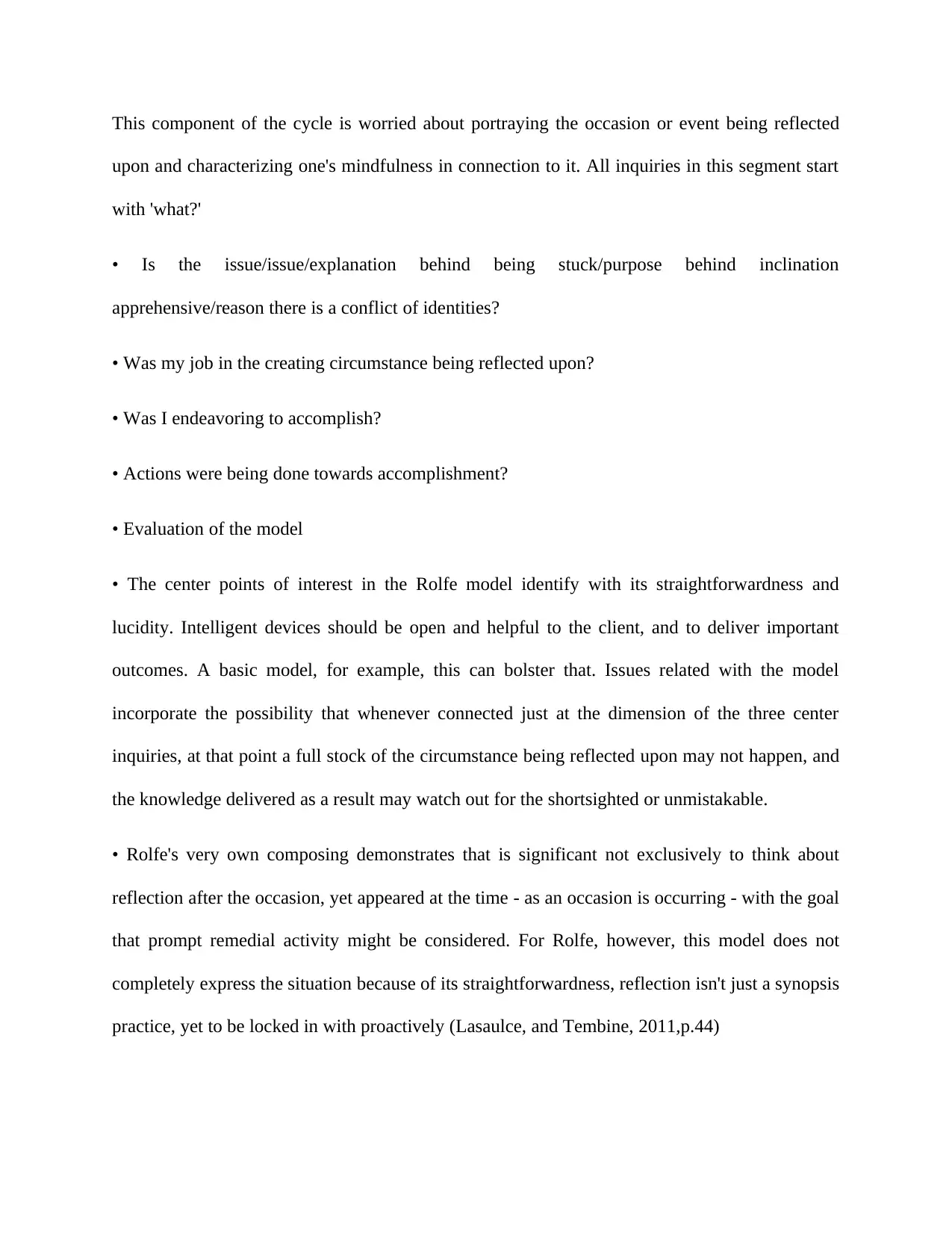
This component of the cycle is worried about portraying the occasion or event being reflected
upon and characterizing one's mindfulness in connection to it. All inquiries in this segment start
with 'what?'
• Is the issue/issue/explanation behind being stuck/purpose behind inclination
apprehensive/reason there is a conflict of identities?
• Was my job in the creating circumstance being reflected upon?
• Was I endeavoring to accomplish?
• Actions were being done towards accomplishment?
• Evaluation of the model
• The center points of interest in the Rolfe model identify with its straightforwardness and
lucidity. Intelligent devices should be open and helpful to the client, and to deliver important
outcomes. A basic model, for example, this can bolster that. Issues related with the model
incorporate the possibility that whenever connected just at the dimension of the three center
inquiries, at that point a full stock of the circumstance being reflected upon may not happen, and
the knowledge delivered as a result may watch out for the shortsighted or unmistakable.
• Rolfe's very own composing demonstrates that is significant not exclusively to think about
reflection after the occasion, yet appeared at the time - as an occasion is occurring - with the goal
that prompt remedial activity might be considered. For Rolfe, however, this model does not
completely express the situation because of its straightforwardness, reflection isn't just a synopsis
practice, yet to be locked in with proactively (Lasaulce, and Tembine, 2011,p.44)
upon and characterizing one's mindfulness in connection to it. All inquiries in this segment start
with 'what?'
• Is the issue/issue/explanation behind being stuck/purpose behind inclination
apprehensive/reason there is a conflict of identities?
• Was my job in the creating circumstance being reflected upon?
• Was I endeavoring to accomplish?
• Actions were being done towards accomplishment?
• Evaluation of the model
• The center points of interest in the Rolfe model identify with its straightforwardness and
lucidity. Intelligent devices should be open and helpful to the client, and to deliver important
outcomes. A basic model, for example, this can bolster that. Issues related with the model
incorporate the possibility that whenever connected just at the dimension of the three center
inquiries, at that point a full stock of the circumstance being reflected upon may not happen, and
the knowledge delivered as a result may watch out for the shortsighted or unmistakable.
• Rolfe's very own composing demonstrates that is significant not exclusively to think about
reflection after the occasion, yet appeared at the time - as an occasion is occurring - with the goal
that prompt remedial activity might be considered. For Rolfe, however, this model does not
completely express the situation because of its straightforwardness, reflection isn't just a synopsis
practice, yet to be locked in with proactively (Lasaulce, and Tembine, 2011,p.44)
Paraphrase This Document
Need a fresh take? Get an instant paraphrase of this document with our AI Paraphraser
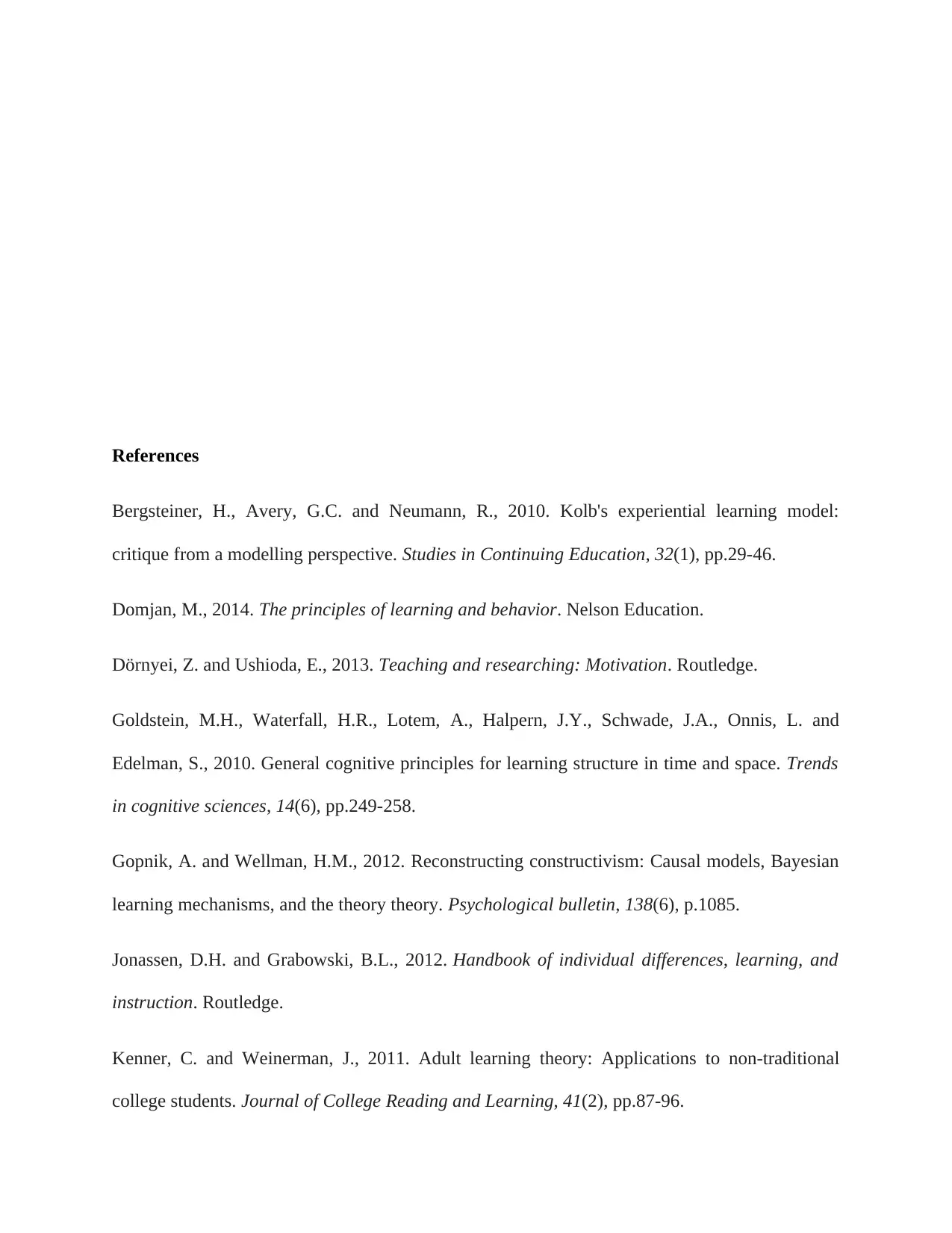
References
Bergsteiner, H., Avery, G.C. and Neumann, R., 2010. Kolb's experiential learning model:
critique from a modelling perspective. Studies in Continuing Education, 32(1), pp.29-46.
Domjan, M., 2014. The principles of learning and behavior. Nelson Education.
Dörnyei, Z. and Ushioda, E., 2013. Teaching and researching: Motivation. Routledge.
Goldstein, M.H., Waterfall, H.R., Lotem, A., Halpern, J.Y., Schwade, J.A., Onnis, L. and
Edelman, S., 2010. General cognitive principles for learning structure in time and space. Trends
in cognitive sciences, 14(6), pp.249-258.
Gopnik, A. and Wellman, H.M., 2012. Reconstructing constructivism: Causal models, Bayesian
learning mechanisms, and the theory theory. Psychological bulletin, 138(6), p.1085.
Jonassen, D.H. and Grabowski, B.L., 2012. Handbook of individual differences, learning, and
instruction. Routledge.
Kenner, C. and Weinerman, J., 2011. Adult learning theory: Applications to non-traditional
college students. Journal of College Reading and Learning, 41(2), pp.87-96.
Bergsteiner, H., Avery, G.C. and Neumann, R., 2010. Kolb's experiential learning model:
critique from a modelling perspective. Studies in Continuing Education, 32(1), pp.29-46.
Domjan, M., 2014. The principles of learning and behavior. Nelson Education.
Dörnyei, Z. and Ushioda, E., 2013. Teaching and researching: Motivation. Routledge.
Goldstein, M.H., Waterfall, H.R., Lotem, A., Halpern, J.Y., Schwade, J.A., Onnis, L. and
Edelman, S., 2010. General cognitive principles for learning structure in time and space. Trends
in cognitive sciences, 14(6), pp.249-258.
Gopnik, A. and Wellman, H.M., 2012. Reconstructing constructivism: Causal models, Bayesian
learning mechanisms, and the theory theory. Psychological bulletin, 138(6), p.1085.
Jonassen, D.H. and Grabowski, B.L., 2012. Handbook of individual differences, learning, and
instruction. Routledge.
Kenner, C. and Weinerman, J., 2011. Adult learning theory: Applications to non-traditional
college students. Journal of College Reading and Learning, 41(2), pp.87-96.
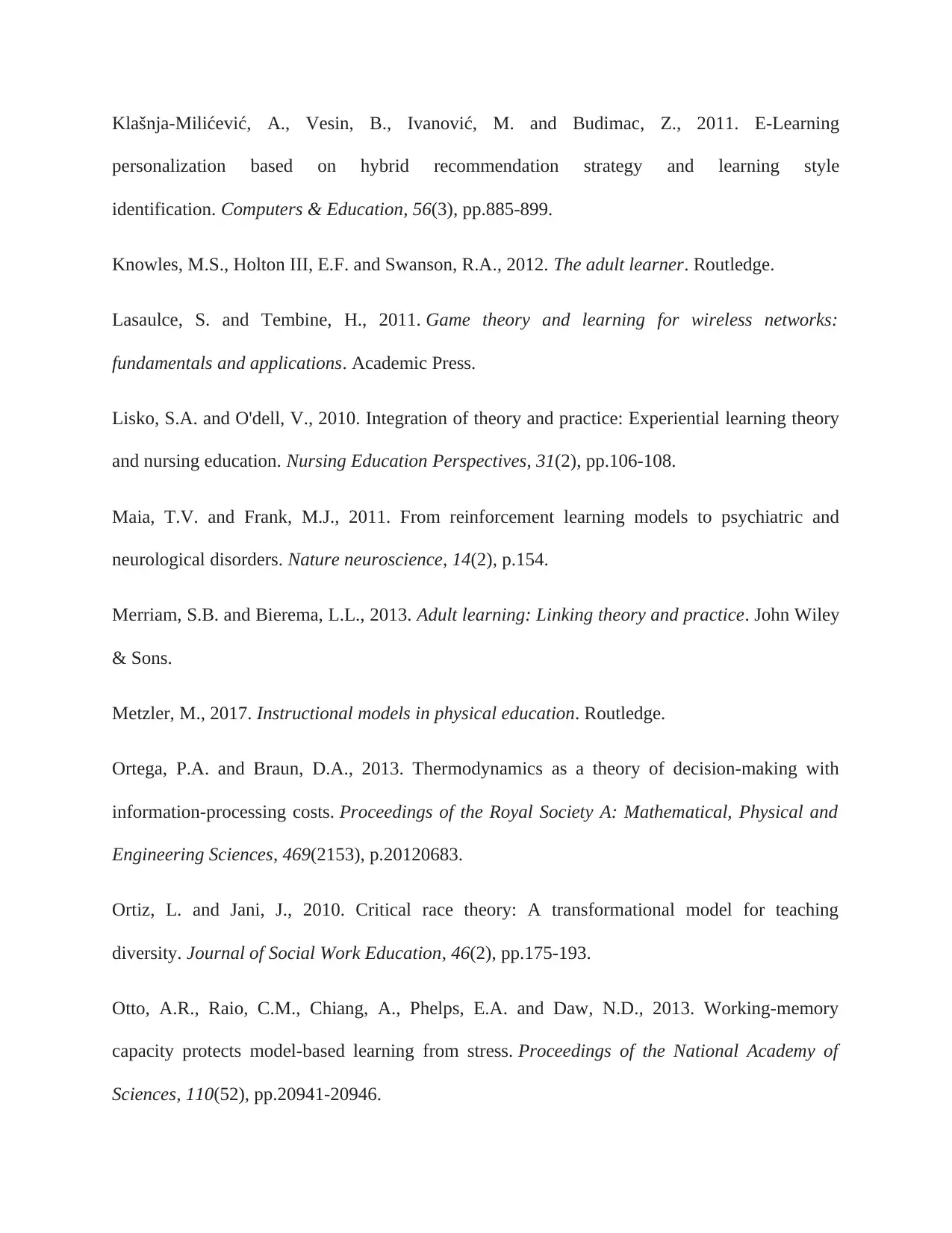
Klašnja-Milićević, A., Vesin, B., Ivanović, M. and Budimac, Z., 2011. E-Learning
personalization based on hybrid recommendation strategy and learning style
identification. Computers & Education, 56(3), pp.885-899.
Knowles, M.S., Holton III, E.F. and Swanson, R.A., 2012. The adult learner. Routledge.
Lasaulce, S. and Tembine, H., 2011. Game theory and learning for wireless networks:
fundamentals and applications. Academic Press.
Lisko, S.A. and O'dell, V., 2010. Integration of theory and practice: Experiential learning theory
and nursing education. Nursing Education Perspectives, 31(2), pp.106-108.
Maia, T.V. and Frank, M.J., 2011. From reinforcement learning models to psychiatric and
neurological disorders. Nature neuroscience, 14(2), p.154.
Merriam, S.B. and Bierema, L.L., 2013. Adult learning: Linking theory and practice. John Wiley
& Sons.
Metzler, M., 2017. Instructional models in physical education. Routledge.
Ortega, P.A. and Braun, D.A., 2013. Thermodynamics as a theory of decision-making with
information-processing costs. Proceedings of the Royal Society A: Mathematical, Physical and
Engineering Sciences, 469(2153), p.20120683.
Ortiz, L. and Jani, J., 2010. Critical race theory: A transformational model for teaching
diversity. Journal of Social Work Education, 46(2), pp.175-193.
Otto, A.R., Raio, C.M., Chiang, A., Phelps, E.A. and Daw, N.D., 2013. Working-memory
capacity protects model-based learning from stress. Proceedings of the National Academy of
Sciences, 110(52), pp.20941-20946.
personalization based on hybrid recommendation strategy and learning style
identification. Computers & Education, 56(3), pp.885-899.
Knowles, M.S., Holton III, E.F. and Swanson, R.A., 2012. The adult learner. Routledge.
Lasaulce, S. and Tembine, H., 2011. Game theory and learning for wireless networks:
fundamentals and applications. Academic Press.
Lisko, S.A. and O'dell, V., 2010. Integration of theory and practice: Experiential learning theory
and nursing education. Nursing Education Perspectives, 31(2), pp.106-108.
Maia, T.V. and Frank, M.J., 2011. From reinforcement learning models to psychiatric and
neurological disorders. Nature neuroscience, 14(2), p.154.
Merriam, S.B. and Bierema, L.L., 2013. Adult learning: Linking theory and practice. John Wiley
& Sons.
Metzler, M., 2017. Instructional models in physical education. Routledge.
Ortega, P.A. and Braun, D.A., 2013. Thermodynamics as a theory of decision-making with
information-processing costs. Proceedings of the Royal Society A: Mathematical, Physical and
Engineering Sciences, 469(2153), p.20120683.
Ortiz, L. and Jani, J., 2010. Critical race theory: A transformational model for teaching
diversity. Journal of Social Work Education, 46(2), pp.175-193.
Otto, A.R., Raio, C.M., Chiang, A., Phelps, E.A. and Daw, N.D., 2013. Working-memory
capacity protects model-based learning from stress. Proceedings of the National Academy of
Sciences, 110(52), pp.20941-20946.
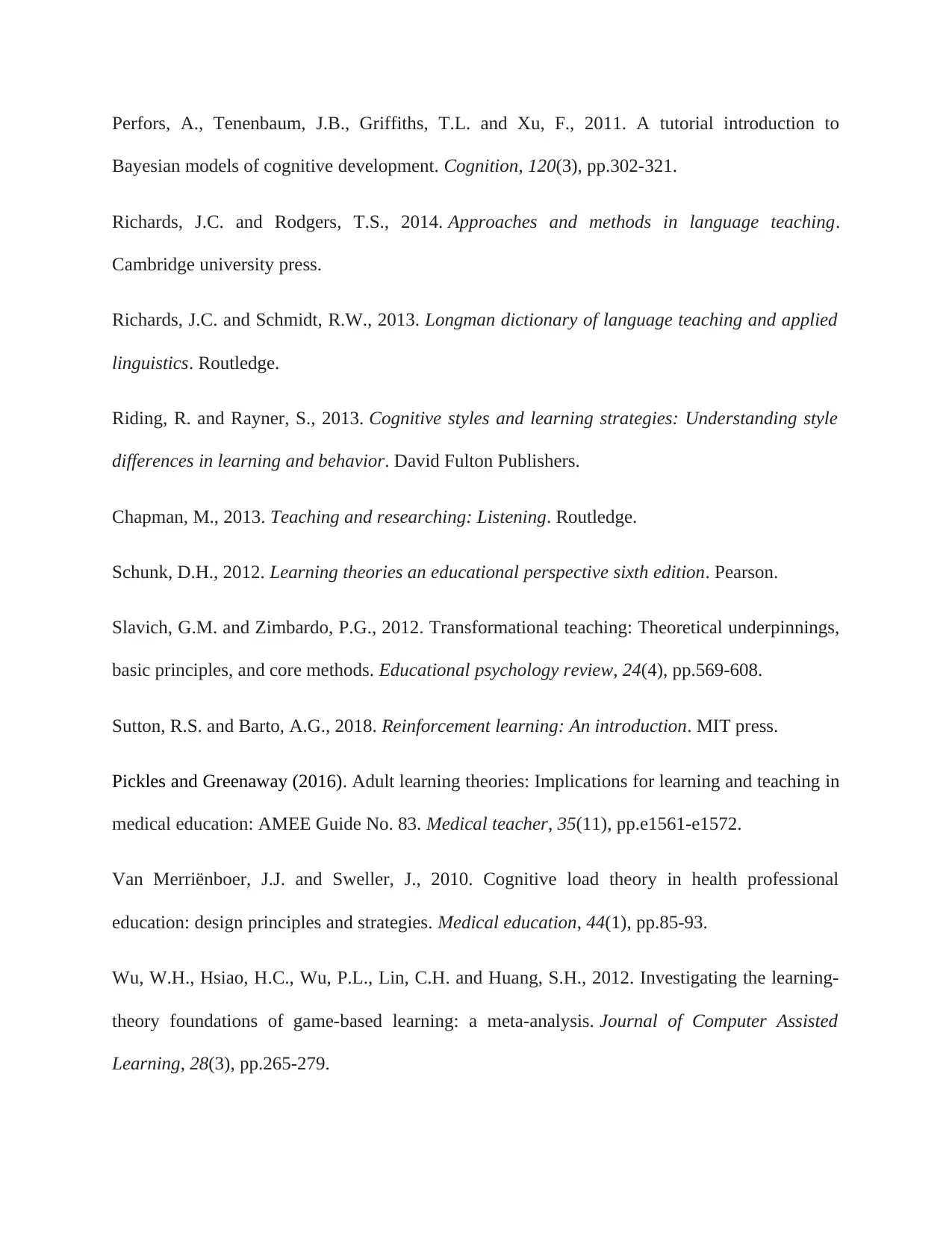
Perfors, A., Tenenbaum, J.B., Griffiths, T.L. and Xu, F., 2011. A tutorial introduction to
Bayesian models of cognitive development. Cognition, 120(3), pp.302-321.
Richards, J.C. and Rodgers, T.S., 2014. Approaches and methods in language teaching.
Cambridge university press.
Richards, J.C. and Schmidt, R.W., 2013. Longman dictionary of language teaching and applied
linguistics. Routledge.
Riding, R. and Rayner, S., 2013. Cognitive styles and learning strategies: Understanding style
differences in learning and behavior. David Fulton Publishers.
Chapman, M., 2013. Teaching and researching: Listening. Routledge.
Schunk, D.H., 2012. Learning theories an educational perspective sixth edition. Pearson.
Slavich, G.M. and Zimbardo, P.G., 2012. Transformational teaching: Theoretical underpinnings,
basic principles, and core methods. Educational psychology review, 24(4), pp.569-608.
Sutton, R.S. and Barto, A.G., 2018. Reinforcement learning: An introduction. MIT press.
Pickles and Greenaway (2016). Adult learning theories: Implications for learning and teaching in
medical education: AMEE Guide No. 83. Medical teacher, 35(11), pp.e1561-e1572.
Van Merriënboer, J.J. and Sweller, J., 2010. Cognitive load theory in health professional
education: design principles and strategies. Medical education, 44(1), pp.85-93.
Wu, W.H., Hsiao, H.C., Wu, P.L., Lin, C.H. and Huang, S.H., 2012. Investigating the learning‐
theory foundations of game‐based learning: a meta‐analysis. Journal of Computer Assisted
Learning, 28(3), pp.265-279.
Bayesian models of cognitive development. Cognition, 120(3), pp.302-321.
Richards, J.C. and Rodgers, T.S., 2014. Approaches and methods in language teaching.
Cambridge university press.
Richards, J.C. and Schmidt, R.W., 2013. Longman dictionary of language teaching and applied
linguistics. Routledge.
Riding, R. and Rayner, S., 2013. Cognitive styles and learning strategies: Understanding style
differences in learning and behavior. David Fulton Publishers.
Chapman, M., 2013. Teaching and researching: Listening. Routledge.
Schunk, D.H., 2012. Learning theories an educational perspective sixth edition. Pearson.
Slavich, G.M. and Zimbardo, P.G., 2012. Transformational teaching: Theoretical underpinnings,
basic principles, and core methods. Educational psychology review, 24(4), pp.569-608.
Sutton, R.S. and Barto, A.G., 2018. Reinforcement learning: An introduction. MIT press.
Pickles and Greenaway (2016). Adult learning theories: Implications for learning and teaching in
medical education: AMEE Guide No. 83. Medical teacher, 35(11), pp.e1561-e1572.
Van Merriënboer, J.J. and Sweller, J., 2010. Cognitive load theory in health professional
education: design principles and strategies. Medical education, 44(1), pp.85-93.
Wu, W.H., Hsiao, H.C., Wu, P.L., Lin, C.H. and Huang, S.H., 2012. Investigating the learning‐
theory foundations of game‐based learning: a meta‐analysis. Journal of Computer Assisted
Learning, 28(3), pp.265-279.
Secure Best Marks with AI Grader
Need help grading? Try our AI Grader for instant feedback on your assignments.
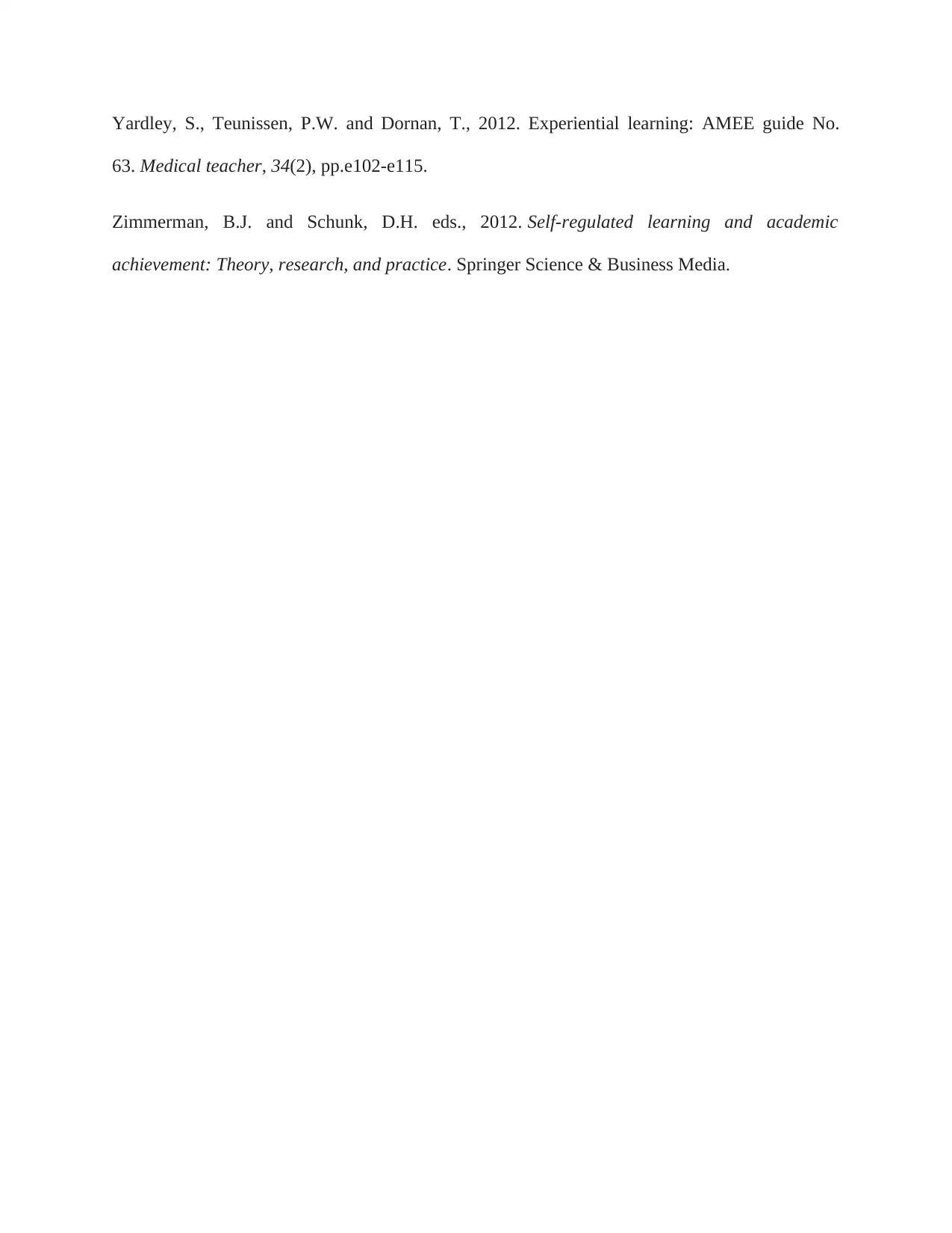
Yardley, S., Teunissen, P.W. and Dornan, T., 2012. Experiential learning: AMEE guide No.
63. Medical teacher, 34(2), pp.e102-e115.
Zimmerman, B.J. and Schunk, D.H. eds., 2012. Self-regulated learning and academic
achievement: Theory, research, and practice. Springer Science & Business Media.
63. Medical teacher, 34(2), pp.e102-e115.
Zimmerman, B.J. and Schunk, D.H. eds., 2012. Self-regulated learning and academic
achievement: Theory, research, and practice. Springer Science & Business Media.
1 out of 20
Related Documents
Your All-in-One AI-Powered Toolkit for Academic Success.
+13062052269
info@desklib.com
Available 24*7 on WhatsApp / Email
![[object Object]](/_next/static/media/star-bottom.7253800d.svg)
Unlock your academic potential
© 2024 | Zucol Services PVT LTD | All rights reserved.





